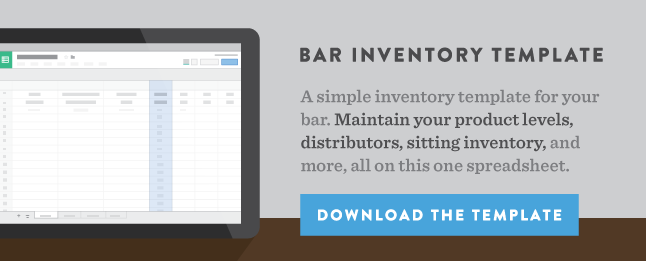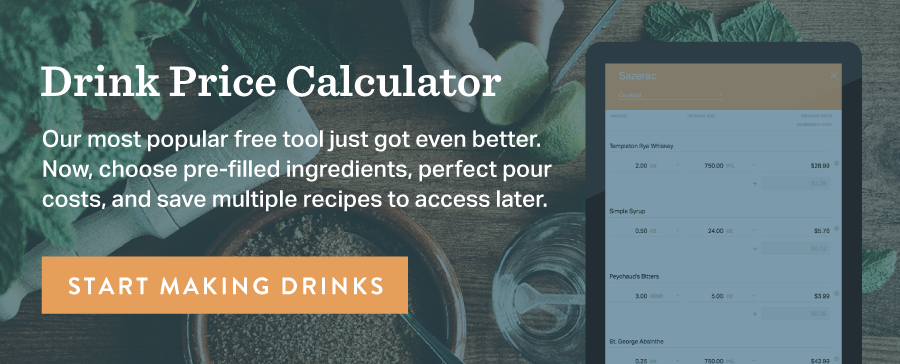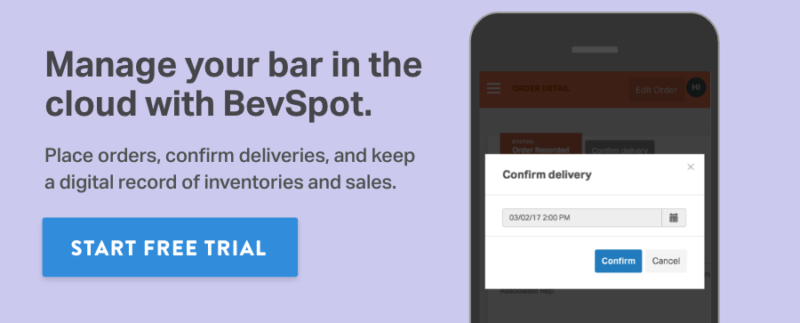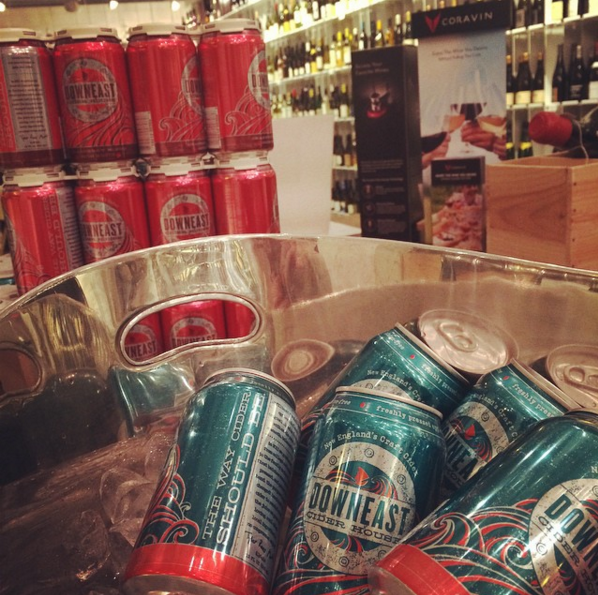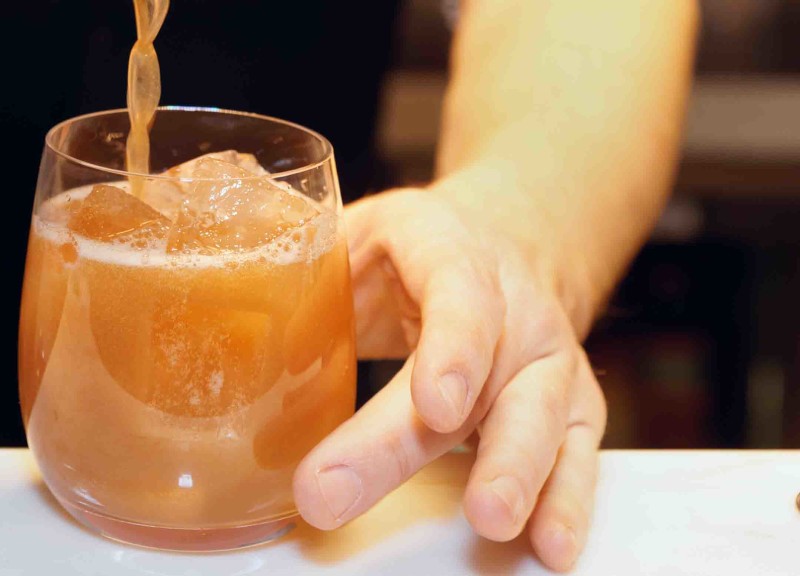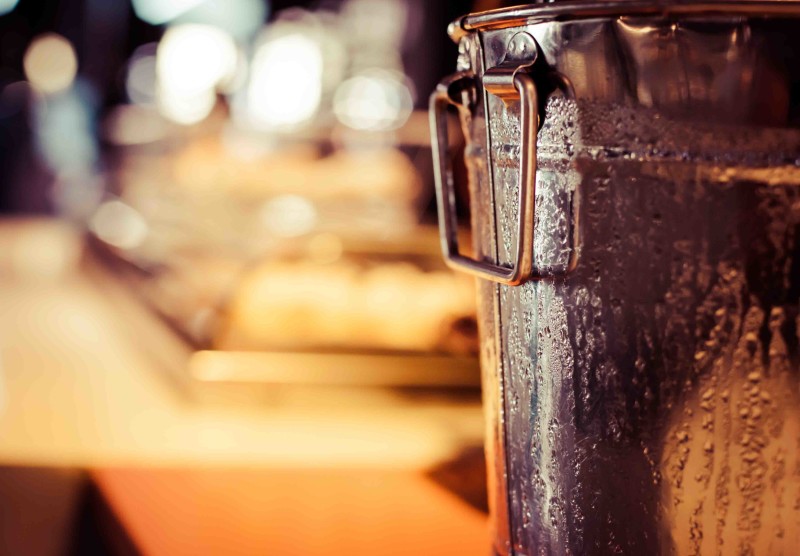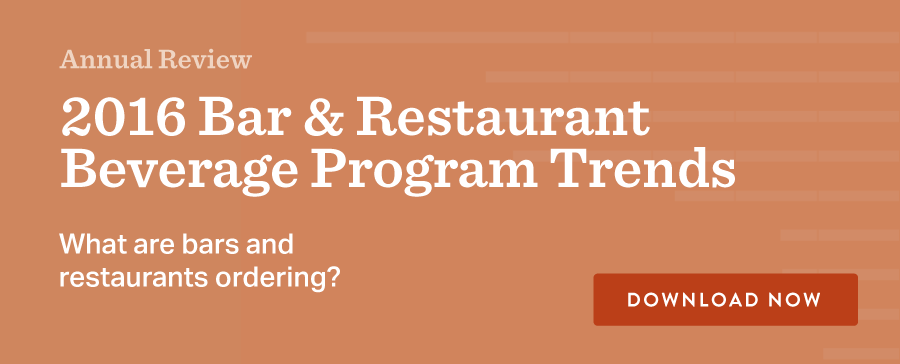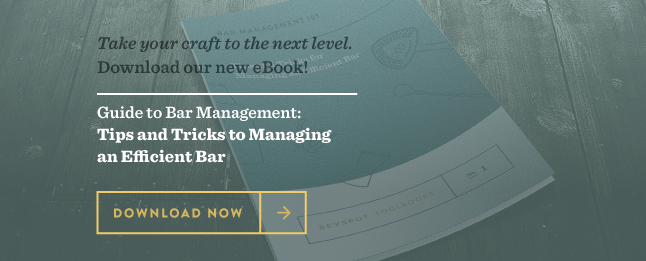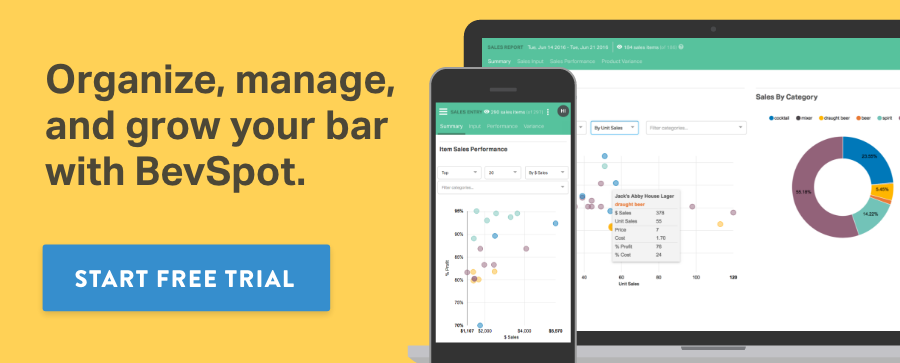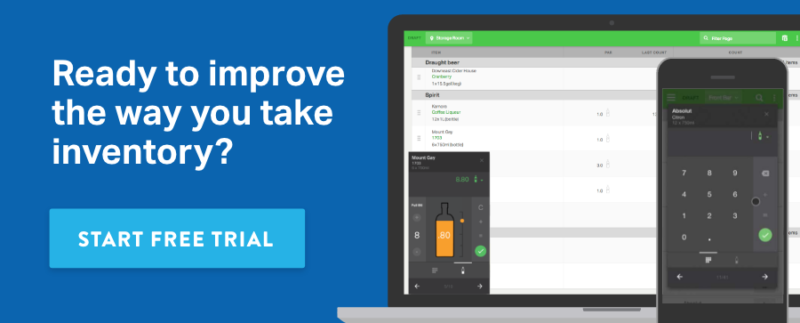How to Count a Keg in Inventory—Bar Management
We’re often asked questions about how to count kegs in inventory.
Questions range from “What’s the best method to use?” and “How many ounces in a keg?” to queries such as, “Should I use a keg scale?” or, more simply, “How many beers are in a keg?” Bar inventory can be a difficult process, and counting kegs is certainly one of the most ambiguous parts. It can get pretty confusing.
Here are four ways to count kegs in inventory.
Start Your Free Trial With Bevspot Today!
1. The Touch-and-Guess Method
When calculating inventory usage for a bar, factoring in the keg is one aspect that many bartenders struggle with. The touch-and-guess method is the most common industry practice for measuring kegs, but it’s also the least accurate.
The touch-and-guess method involves a physical observation, either by kicking, lifting, or shaking the keg. The next step is to estimate how much liquid is left by guessing to the tenth. For example, if, after kicking it, the keg sounds quite hollow, you could guess that it might be 30% full, or at 0.3. On the other hand, if it sounds fairly heavy, you might guess that it’s sitting at around 0.8.
However, the flaw in this method lies in individual judgement calls. One bartender’s 0.7 might be another’s 0.5, creating inaccurate recordings in your inventory count.
This is bad news.
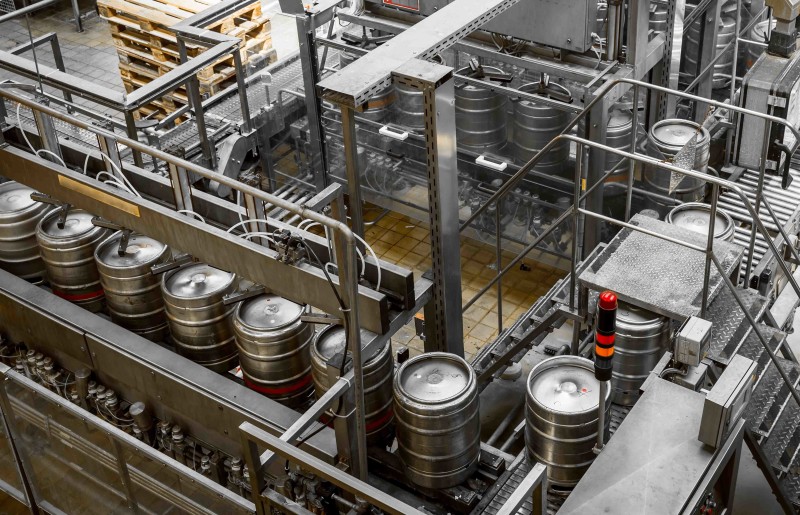
Find out how to take inventory 3x faster.
2. The Keg Scale
A more precise way to measure a keg for inventory is by using a keg scale. These can be purchased from most scale manufacturers or online (just make sure to buy one that can take at least 300 pounds).
Most bartenders have a system in place that helps them translate weight to number of beers. And depending on the size of your kegs, you’ll need to account for a tare weight, too, which you can determine by first weighing one or two empty kegs. You’ll also need to be aware of the keg’s tap lines—it’s fine to weigh kegs while they’re still tapped, but make sure you’re not alternating between tapped and untapped kegs, as the weights will vary.
The only downside of a keg scale is the need to move and lift heavy kegs onto the platform—this can take time and some employees may struggle with the physical demand, creating a safety issue.
3. The Keg Check
The Keg Check is one of the more popular gadgets used by the commercial bar industry. It’s an attachable wrench that measures the amount of beer left in a keg. After fixing the gadget to the rim of the keg, you can pull back on it, allowing the scale to read the weight of the keg, either in liters or gallons. It’s fast, accurate, and easy to use, and there’s no heavy lifting involved. It’s also fairly affordable.
4. Other Keg Readers
There are several other lesser-known gadgets that offer options for how to count kegs.
There are products like the Smart Strip Thermometer Reader. These are strips that can be attached to the outside of the keg and use thermometric sensing to display the level of the beer.
Then there are a variety of digital flow readers that can be fixed to a keg’s tap lines to measure the ounces or liters of beer that flow through.
Why Accurate Keg Inventory Matters
POS systems can be an absolute nightmare, we know. But tracking your sales usage along with accurate keg measurement is crucial.
In BevSpot, you can easily upload your POS reports to our platform. We’ll take all that messy sales information and turn it into easy-to-read data. You’ll see how many beers you sold from a specific keg and can compare these numbers directly with your inventory counts.
However, you’ll only be able to identify variance (foam, over-pour, or theft) by measuring your kegs. And by observing your inventory usage this way (comparing your sales usage to your actual usage) you’ll have a complete overview of the product variance for all of your kegs—too easy.
The margin of error in beer inventory management is notoriously high, industry wide. Inaccurate counts mean lost product which means dollars down the drain. Got any methods of your own? Let us know in the comments below!
For more advice and the latest bar industry tips, head to our guide to bar management page.
Think you need a little extra help managing your bar’s inventory? Get in touch with one of our product specialists to find out how we can help.
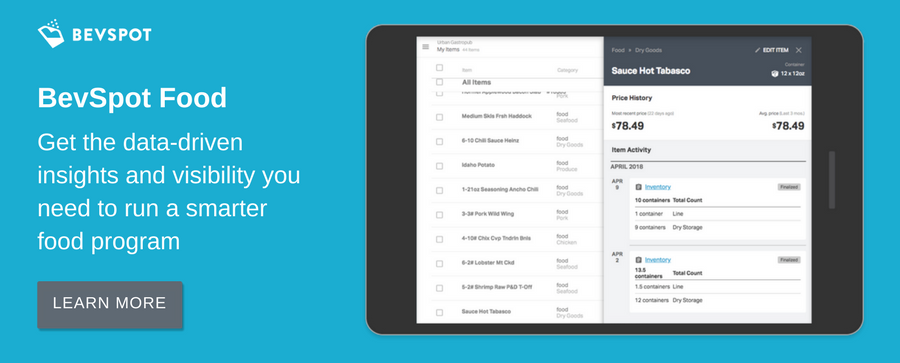
Start a FREE Trial Today! BevSpot offers full product education and account setup for all customers! No card Information needed!
Calculating (and Interpreting) Pour Costs
Calculating inventory usage is important to many different aspects of bar management. Setting pars is a great way to utilize inventory usage data. But an even more important calculation is your bar’s pour costs (often referred to as “percentages”).
How to Calculate Pour Cost
To calculate your pour cost, take your total inventory usage (or cost of goods sold) and divide it by your total sales:
Pour Costs =
Inventory Usage/Sales
*(Or for you business nerds out there, 1 – Gross Margin)
Controlling Pour Costs
Pour costs are an essential barometer for bar profitability, and since running a bar can be costly, controlling pour costs (meaning keeping them as low as possible) can account for the difference between a wildly successful bar and a failing one.
Consider the following scenario: Bar A and Bar B are located next door to one another. Both sell around $1M at the bar each year, but Bar A runs a 20% Pour Cost and Bar B runs a 30% Pour Cost. Bar A, on the exact same sales with roughly the same client base, will make $100,000 more in profits each year!
This may seem like an extreme example, but we regularly interact with bars on both ends of this spectrum.
Interpreting Pour Costs
So what’s the deal here? Why is Bar A making so much more money per year with the same products, location, and client base?
To figure this out, we not only need to be able to calculate pour costs, we need to interpret that calculation. Interpreting pour costs is one of the most misunderstood aspects in managing a bar—it seems difficult, confusing, and time consuming. But it doesn’t have to be when equipped with the proper tools.
A simplified breakdown can help in understanding the effects of pour costs, which are really only influenced by three factors: 1) drink costs 2) drink prices and 3) product loss.
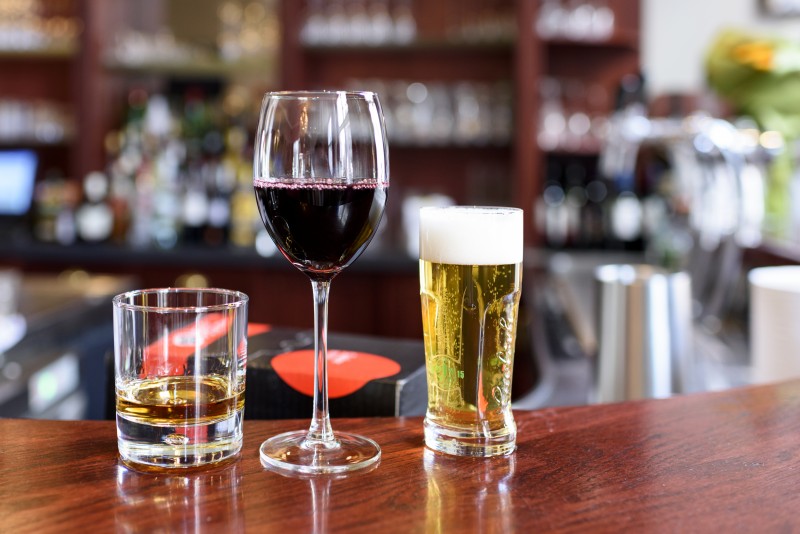
1) Drink Costs: How much you pay for your product directly influences your pour costs. When product costs increase, the prices you charge should increase as well, otherwise you’ll see your pour costs go up and your profit levels go down. By taking advantage of distributor discounts and deals on products, you can help keep your pour costs down, of course, let’s not forget about the risks of sitting inventory and shrinkage that come along with ordering in bulk discounts.
2) Drink Prices: What you charge for a drink is decided by a few different factors. Your bar’s location, client base and client preferences between beer, spirits, and wine will all ultimately influence the amount that you charge for a drink. Being very thoughtful about effectively pricing your drinks will help maximize your potential profit (and therefore minimize your pour costs).
3) Product Loss: The final influence of pour costs has to do with what you actually sold versus what you should have sold based on the amount of inventory used (otherwise known as inventory variance). In a perfect world, these numbers would line up almost exactly. In actuality, loss (or shrinkage) is an unavoidable obstacle that you need to account for. Over-pouring, broken bottles, spoiled product (for wines poured by the glass), giving away drinks to regulars/friends/staff, and theft are all common reasons that your sales don’t match up perfectly with your inventory.
Now for the big question: does your bar have a problem with drink prices or product loss? Stay tuned in our Bar Management 101 series and we’ll explore in more depth how to lower your pour costs!
Spark the Romance with These 5 Aphrodisiac Cocktails
5 Aphrodisiac Cocktails
Valentine’s Day is quickly approaching. Pretty soon, every bar will be featuring pink and red drinks with lovey-dovey names like “Cupid’s Arrow” or “True Love’s Kiss.” Not that there’s anything wrong with that; we love getting in the holiday spirit, and who doesn’t love a little romance? But there are tons of cutesy, heart-shaped Valentine’s Day candies and pretty pink drinks. So, why not offer something a little different that will really get your patrons in the low-light mood? Think outside the box and create an interesting V-Day list with aphrodisiac cocktails. Afterall, we’re all adults here.
Aphrodisiacs
An aphrodisiac is defined as “a food, drink, or drug that stimulates sexual desire.” Although the degree of their effectiveness is still up for debate, men and women have sought aphrodisiacs for centuries. Considered catalysts for love, these innovative ingredients can make a great addition to your Valentine’s Day cocktail menu.
Whether fact or myth, these aphrodisiac ingredients are sure to spice up your cocktail:
- hot chili peppers
- asparagus
- bananas
- chocolate
- oysters
- pomegranates
- red wine
- vanilla
- watermelon
- honey
- coffee
- strawberries
- chai tea
- cherries
- figs
- eggs
- cinnamon
- avocado
We realize this is a wide range of ingredients, so here are some recipes that will be sure to turn up the heat.
Frisky Cocktails
For hundreds of years, oysters have been considered a love catalyst. More recent research has shown that the zinc and amino acids in oysters may be what’s causing the libido boost.
Recipe
Spicy Oyster Shooters
Ingredients
- 2 stalks of celery tips (with leaves)
- ¼ lemon
- 2 live blue point oysters
- 5 drops of Tabasco sauce
- ½ teaspoon of Worcestershire sauce
- ½ teaspoon cocktail sauce
- 1 ounce Bloody Mary mix
- 1 ounce vodka divided
Directions
- Mix the Bloody Mary mix, Worcestershire sauce, cocktail sauce, and Tabasco drops.
- To remove outside grit, scrub oysters under cool running water. With the oyster flat side up, jab a small knife into the hinge to pop the oyster open. Drain the juice into the Bloody Mary mixture.
- Scrape the oysters away from the shells and drop them into each shot glass.
- Pour 1/2 oz vodka into each shot glass.
- Evenly divide the Bloody Mary mixture into each glass and squeeze with lemon juice.
- Garnish with the celery tip.
I don’t know about you, but when I think romance, I think chocolate covered strawberries. Plus, what’s more delicious?
Recipe
Chocolate Covered Strawberry
Ingredients
- 4 parts vodka
- 2 parts strawberry liqueur
- 1 part white chocolate liqueur
- 1 whole chocolate
- 1 whole strawberry
Directions
- Fill shaker with ice cubes.
- Add all ingredients.
- Shake and strain into two cocktail glasses.
- Garnish with chocolate and a strawberry.
An avocado cocktail is definitely outside the box. The Aztecs believed that avocados increase fertility and boost stamina. It’s been said that men picked the avocados and women were kept inside for fear that the scent of avocados would drive them into a “passion frenzy.”
Recipe
Avocado Daiquiri
Ingredients
- 2 ounce light rum
- 2 ounce gold rum
- ½ ounce fresh lemon juice
- ½ ounce fresh lime juice
- 2 ounces simple syrup
- ¼ medium-ripe avocado, peeled and pitted
- ½ ounce half-and-half
- 1 ½ cup ice
Directions
- Combine ingredients in blender.
- Blend for about 20 seconds.
- Divide between two cocktail glasses and serve.
Cinnamon is a great way to turn up the heat. Get the blood pumping with this chocolatey cinnamony concoction, courtesy of Hennessy VS.
Recipe
XOXOXO
Ingredients
- 1.5 oz Hennessy XO
- .5 oz sweet vermouth
- .5 oz Creme Yvette
- 1 dash Angostura Bitters
- 1 dash chocolate bitters
- 3 muddled black cherries
- ⅛ of a lemon
- freshly grated cinnamon
Directions
- Muddle cherries and lemon in a shaker tin.
- Add all liquids to shake with ice.
- Shake until chilled.
- Strain into rocks glass on top of ice cubes.
- Grate cinnamon over top.
- Garnish with cherry.
This drink is sure to get your customers buzzing. Served hot and hosting a nice combination of two aphrodisiacs, coffee and honey, this drink is definitely a great addition to any Valentine’s Day cocktail list.
Recipe
HoneyBee
Ingredients
- 1 ½ ounce Honey Jack Daniels Whiskey
- 1 ounce brown sugar simple syrup
- 4 ounces coffee
- cream
- whipped cream
Directions
- Mix equal parts brown sugar and hot water until the sugar is dissolved to make brown sugar simple syrup.
- Combine coffee, cream, simple syrup, and whiskey in a cocktail shaker filled with ice.
- Shake.
- Strain into a glass.
- Garnish with whipped cream.
Go get frisky with these aphrodisiac cocktails and have a happy Valentine’s Day!
Schedule 15mins to chat with a product specialist
Start a FREE Trial Today! BevSpot offers full product education and account setup for all customers! No card Information needed!
Meet the World’s Best Bartender of 2015: Ryan Lyan
Last year, Ryan Chetiyawardana—otherwise known as Ryan Lyan or Mr. Lyan—was awarded the prestigious title of International Bartender of the Year at the Spirited Awards.
He owns two of the best bars in London: White Lyan, which was recently named best new international cocktail bar and the no. 1 place to drink in London, and Dandelyan, which was also voted world’s best new bar and the best place to drink in the UK. These accomplishments are huge, and there’s a great story behind them.
Upon arriving at White Lyan, you’ll find a stylish, low-lit room with exposed brick and a soft, white glow coming from behind the bar. It may sound like a familiar scene, but the bar itself operates like no other.
Believe it or not, White Lyan produces almost no waste; they use no ice, no perishable ingredients, and no garnishes. Every single spirit is house-made. It’s a concept that requires a lot of work, but the string of awards and the endorsement by customers like Beyonce and Jay Z demonstrate Ryan’s influence.
He’s developing revolutionary bartending practices and challenging industry perceptions all over the world.
Ryan’s sensitive approach to the people who visit his bars has been cultivated during years of working in the industry. Not only does he place hospitality as the hallmark of a great bartender, he sees it as just as important—if not even more so—as the mind-blowing cocktails he develops.
Some call him “the mad scientist of the cocktail world.” Our opinion? He’s pioneering a new wave of revolution in the bar industry.
So, how does Mr. Lyan do it? How does one become the International Bartender of the Year while running two of the best bars in the world and systematically changing the face of the industry?
Let’s find out…
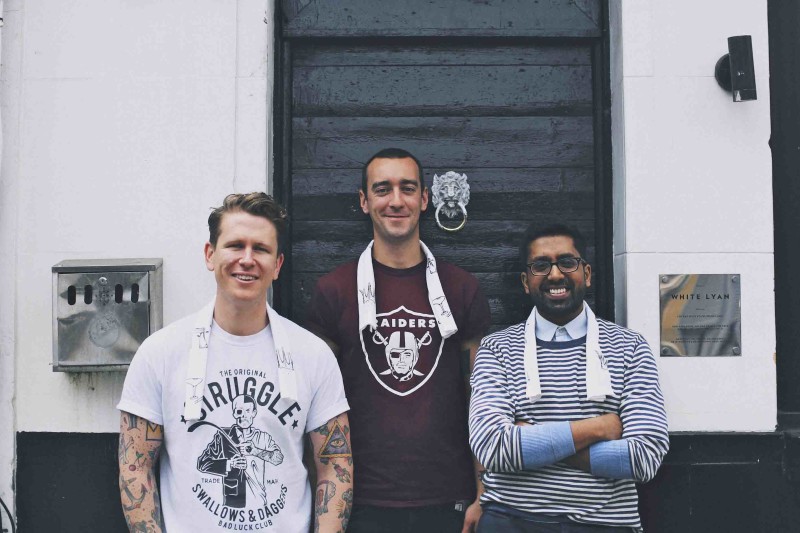
Your innovative approach to traditional bartending, and the bar industry as a whole, has been creating some great conversations. How do you feel about that?
“That’s great to hear! It’s always difficult to know the reaction to your work.”
Ryan spent time observing some of the best bars in the world, and he quickly began to realize something—they all viewed traditional methods of bartending as the only acceptable way to make drinks. Finding this process frustrating, he set out to challenge their ideas.
“I’ve always focused on doing things differently—there are great traditional examples out there already, so why would I try and re-hash those? I’ve always tried to reflect my own interests and background and collaborate with like-minded people, and that will always be a focus when challenging the status quo.”
Ryan believes innovation is paramount to any industry, and he has tried to learn, question, and take action in the most honest way possible. “I also have a very short attention span, am constantly intrigued by new information, and love working with people, so it’s fun to be able to focus on the new.”
We know you prefer the term “bartender” to “mixologist.” So what’s your favorite thing about being a bartender and running a bar?
“The people I get to work with and the people I get to meet. They’re what attracted me to the industry in the first place.”
Ryan originally trained as a chef, but he found it strange to have to do all his cooking in a kitchen in the back, which left him feeling disconnected to the people he was trying to create for.
So, he turned to bartending, which gave him the opportunity to still play with flavors but also to chat and interact with people. “I love the stimulation and creative output of bartending, but I’ve met some incredible people and got up to some life-changing experiences with them!”
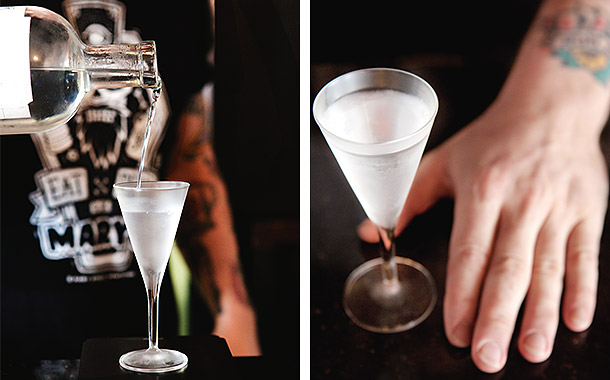
What’s the biggest lesson you’ve learned in this role?
Ryan always tries to question everything and pay attention to the details, but he advises those in the industry to remember that “none of it actually matters.”
“I’m a very positive person, and I learned very quickly that this is a crucial aspect of my (or any!) job—you have to try and aim for the positives wherever possible, in any and all scenarios.”
What’s the most important thing for you as the world’s best bartender?
“It’s important to question whether we, in our bars and as an industry, are doing something that can lead to a better output,” Ryan explains.
“That might be simply making sure we allow ourselves the setup/time/space to make sure a guest feels welcome, or perfecting a drink so it makes someone feel something they never have before.”
“And everything in between,” he says.
Where do you look for inspiration or ideas?
Ryan grew up in Birmingham, and before training as a chef and dominating the world bar scene, he studied both philosophy and biology at two of the UK’s best universities. All of this varying experience has blended together to produce an artistic, scientific, and anthropological mind.
Now, Ryan looks anywhere and everywhere for inspiration. “I’m a complete magpie.”
“But usually,” he says modestly, “the best concepts seem to come to life within our team. I’m very fortunate to be surrounded by some incredible people in my life, and bouncing ideas off them always leads to something stronger.”
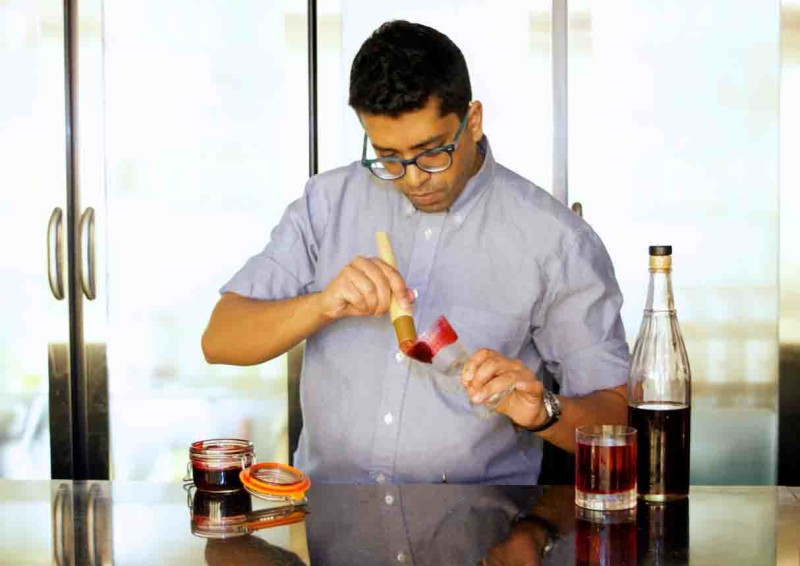
You seem to take a true interest in the people who come into your bar. What’s your main goal as a bartender?
For Ryan, it’s not about the bartender or the drinks—it’s about giving people the best possible experience by helping them relax and be themselves.
“My main goal is to make sure everyone is having the best time they can have in that moment. That, of course, varies, but by treating people as individuals you can respond to their own personal needs from the scenario. Some people come to buy into our offering, some people come to have a wild night, others need to escape their demons, but each can have the best experience possible.”
What’s your biggest piece of advice for aspiring industry professionals?
“Question EVERYTHING.”
What’s your top must-have bar tool?
“A chamber vacuum sealer… Best. Toy. Ever. Aside from that, some good scales.”
You’ve created a menu at White Lyan using only handcrafted liquors, with almost no waste. What are some ways other bartenders can use these methods in their own bars?
Ryan adopts an experimental approach to cocktail making. Featuring no perishable elements, all of White Lyan’s cocktails are devoid of ice and fresh fruit; to be served quickly, efficiently, and at an optimal drinking temperature.
This leaves Ryan with a unique inventory and beverage management process.
“There’s some amazing information out there—books by Dave Arnold and Tristan Stephenson cover lots of ‘modernist’ techniques, but so much can be done with simple research.”
Ryan says the crucial starting point is always—and categorically must be—whether what you’re creating is safe. “That might sound alarmist,” he says, “but many household ingredients and easily accessible foods can be dangerous. By doing some homework and experimenting, you can create amazing things from very simple sources.”
So, how crazy do his cocktails really get?
Ryan takes ingredients we thought we understood and uses them in a completely different way. Most of the cocktails in White Lyan’s repertoire feature unusual ingredients, such as chemicals, minerals, shrubs, and even beeswax.
The “Bone Dry Martini” is composed of chicken bones that have been dissolved in phosphoric acid. The “Moby Dick Sazerac” is made with ambergris, the bile of sperm whales that he collects from the ocean.
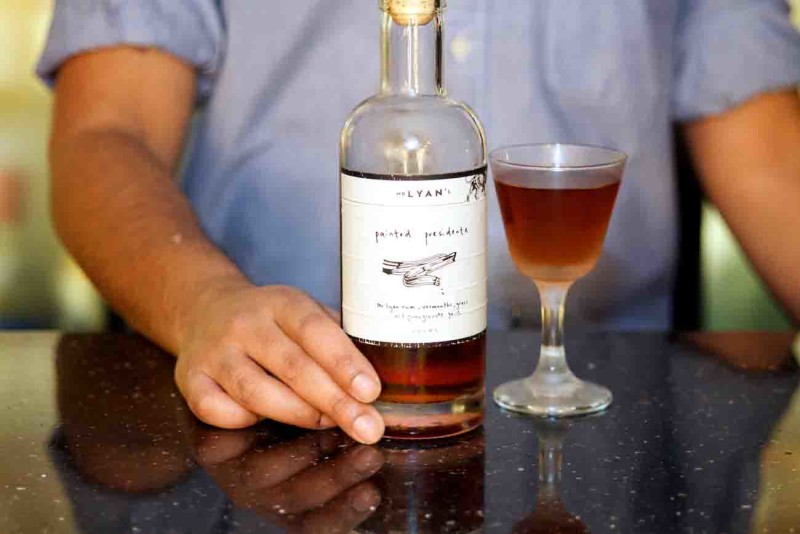
What do you look for when developing new cocktails?
Ryan’s background in biology fuels his experimental approach to flavor combinations, but his creativity goes much deeper than that. “It’s often a story or feeling we’re trying to explore. It shouldn’t ever be about substituting a new flavor into an established formula.”
That can, of course, create a tasty cocktail, he explains, but there should be a reason behind this dynamic. “It’s like when you’re at school—the work is as important as the answer. And it’s why forgeries don’t carry the same gravity as a masterpiece. So we always try and create a dialogue through the drink. That doesn’t need to be academic or profound, but it should be honest.”
This might be a hard question to answer, but do you have a favorite cocktail?
“My favorite is a scotch and soda, but I also love a Martini (small, cold, and snappy, 4:1 with a twist and an olive), a Manhattan (sweet, rye, with a cherry), and a Daiquiri (60:20:10 shaken until blisteringly cold).”
Any cocktail or beverage trends you’re predicting in 2016?
“Bananas! I do love bananas, but it’s more to reflect the playful side coming back into cocktails and bartenders finding ways to employ difficult textures and flavors in interesting ways.”
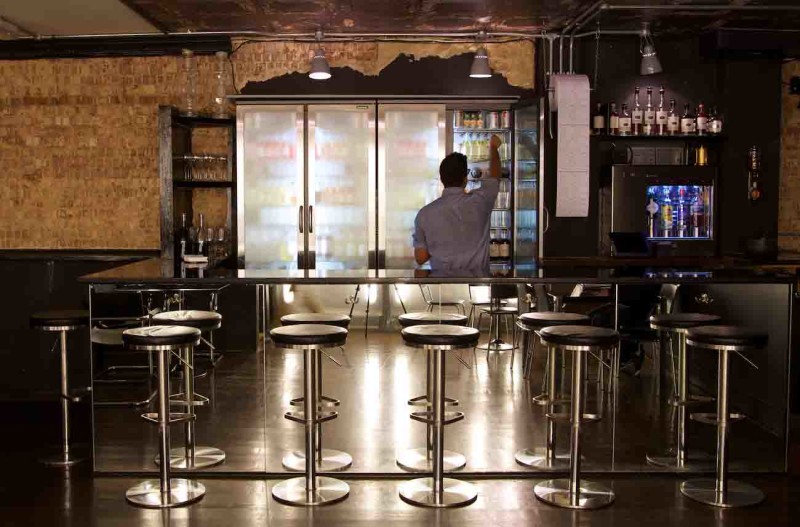
And here’s the good news:
Ryan recently released a book that holds all the secrets to making his cocktails at home or at your own bar. Good Things to Drink with Mr. Lyan and Friends is full of easy-to-make, beautifully photographed cocktails; its simple recipes are perfect for any mood and every occasion.
What were you hoping to achieve with the release of your new book?
“The book was for my friends who aren’t part of the industry, and I wanted to demonstrate the magic that food and drink can have for bringing people together and creating occasions that are super memorable.”
“I wanted to bring the intuition people have for food—about setting, occasion, timing etc.—to drinks. It’s a very simple premise: Demonstrate drinks that fit a scenario through example.”
What are you looking forward to most this year?
“I’m looking forward to further challenging ourselves and the industry, and seeing people and places I’ve never visited before.”
What do you think about innovative technology and software in the bar industry? Do you use any yourself?
“Of course!” Ryan believes innovation is crucial across all aspects of the industry and that technology is allowing us to make massive amounts of progress.
“Some sides of our work are sexier than others, but if there’s some amazing new development that helps us manage our bar or clean the bathrooms better, or reduce waste or carry cases of beer up stairs, then that’s just as important as a new gin!”
Like Ryan, we believe great technology is paving the way for industry innovation. Great tech can save you money and provide you with more time to spend on the important things.
Schedule 15mins to chat with a product specialist
Start a FREE Trial Today! BevSpot offers full product education and account setup for all customers! No card Information needed!
The Story of Downeast Cider
About a year and a half ago, I had my first Downeast Cider.
I’ve always been a fan of hard cider, but I had never tried a hard cider intended to taste like authentic, freshly pressed apple cider. You know? The thick apple consistency. The “nostalgia juice” New Englanders happily drank while visiting apple orchards in the fall or at family gatherings during the holidays when we were too young for adult beverages.
Needless to say, I was intrigued.
After further investigation, I discovered why Downeast tastes like real apple cider— it’s made from locally grown apples, freshly pressed juice (never from concentrate), and ale yeast. The most critical aspect is the fact Downeast Cider is left unfiltered to maintain a pure apple flavor. As a bonus, it’s naturally gluten-free.
In short, it tastes like real apple cider because it is real apple cider.
When I had my first sip, Downeast wasn’t a widely known brand, but now it’s a well-known craft cider name in the New England area. You can walk into almost any Boston bar and order one (sometimes it’s even on draught!) and most liquor stores and specialty grocery stores have it stocked.
Recently, I had a chance to sit down with one of the original founders, Tyler Mosher, to hear the Downeast story straight from the source. As we perched on some empty kegs in the Charlestown cider house, this is what he had to say.
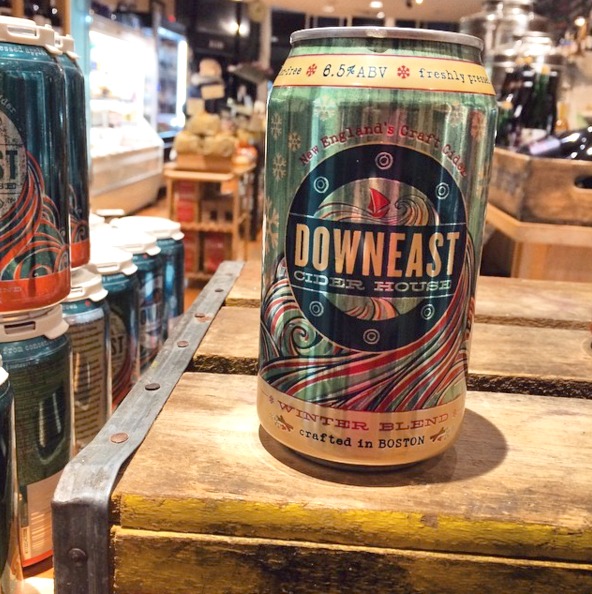
Where did you get the idea to start a cider company?
“It all started at Bates College. A friend of Ross (the other founder) and mine had an apple orchard in Vassalboro, ME. We’d often get bushels of fresh apples from the orchard. Pretty soon, we got fairly snobby about the apples and only ate the best in the bunch. We all developed a love of apples and apple cider. When senior year rolled around, my dad suggested we start a hard cider company together. He explained how hard cider is popular all over the world, but not popular in the US. We probably took that statement a little more seriously than he had intended.”
Once you had the idea, how did you get started?
“We noticed a few things about the hard cider market. The first was the fact that mass-produced cider wasn’t up to our standards, which had been raised by eating fresh apples and drinking fresh juice. The spectrum of ciders consisted of the very sweet stuff made by huge companies, and the smaller craft companies making traditional cider that tasted more like white wine or apple champagne. In our opinion, those two options weren’t good enough for us because they didn’t fall in line with our connotations for the word cider. We were upset about this.”
“The other thing we realized was that craft beer was really popular. It doesn’t sound revolutionary, but as a college kids drinking Keystone Light and Milwaukee’s Best it was, for us… We realized we might be able to build on the craft beer movement with hard cider. Except, we wanted our cider to taste like freshly pressed apple juice. We didn’t know how we were going to do it, yet, but we started making test batches of hard cider during our senior year.”
Where did cider-making take you post graduation?
“Just after graduation, we moved up to Waterville, Maine where we lived on a farm for about six months. We practiced making hard cider all the time, and at this point, we had a couple breakthroughs. The first, in regards to our cider, was that we needed to add a bunch of tannin for it to taste the way we wanted it to. That was pretty big for us.”
“The second breakthrough was fermenting our cider with ale yeast. We wanted our cider to align more with beer instead of wine. We felt like the champagne style ciders weren’t making themselves accessible to the average pub-drinking person. So, we decided, we’d ferment with ale yeast. As a bonus, it tasted better. The third thing we realized was that we didn’t want to filter our cider. This revelation came after we purchased our first piece of equipment, a filter. We sold the filter after we realized filtering stripped out all of the apple flavor we wanted to retain.”
Did you run into any challenges when you were first starting out?
“In Waterville, we had a small, terrible space. At one point in time, it was the bathroom of the mill. We occupied it because it had tile floors and drains. I don’t like telling people that, I think it’s kind of embarrassing. Our first dollars were made by scraping stalls of the bathroom.”
“We sold our first kegs in January of 2012. Pretty soon, we realized people like our cider. At this point, we bit off a little more than we could chew and started distributing to Massachusetts. Our orders tripled overnight and we couldn’t fill any of the orders. Obviously, this caused a lot of issues for us. The person Ross and I started the company with quit. Our apple supplier ran out of apples. Our already insufficient space became unbearable. Finally, we didn’t have enough kegs to put our cider in.
That sounds pretty stressful! How did you overcome these obstacles?
“First, we found a new apple supplier in Massachusetts. Fortunately, our new found apple supplier allowed us to move into his facility in Leominster, MA. We got our feet back under ourselves, bought a manual canning line and started canning. Around the same time, Matt joined us. Then, we moved out of the place in Leominster when we found the space in Charlestown. At this point, the business started to gain momentum. We realized it was something bigger than, ‘just us.’ It’s not just about our daily efforts or waking up in the morning every day, it’s a whole bunch of people’s efforts after waking up in the morning.”
Wow, it’s been quite the journey. Is there anything else you want to add?
“Throughout the entirety of building this company, we’ve made a bunch of mistakes, but our saving grace is our attention to customer service. We stand behind our product and our customers come first.”
Downeast Cider is currently distributed to New England, New York, and New Jersey with plans for expansion. Don’t ask them where because they don’t know. The Original Blend and Cranberry Blend are sold in both 12oz. can 4-packs and on draft year round. Downeast also sells an Original and a Seasonal Sampler 12oz. can 9-pack year round.
From January through March, the seasonal Maple Blend is sold in 12oz. can 4-packs. There are also other specialty offerings currently available on draft. For more information about stocking your bar with Downeast Cider, check out their goods page or contact sales@downeastcider.com.
In the fall, Downeast plans to open up another facility in East Boston at 256 Marginal St. The new space will be used for increased production. The Charlestown location will remain open for tours, events, and the bar.
VIDEO: Top 5 Super Bowl Party Cocktail Recipes
Whether you’re throwing a Super Bowl party at home, or expecting a few hundred people at your bar, here are the Super Bowl Party Cocktail Recipes you’ll want to be serving.
The Super Bowl is here again, and chances are you’ll be watching it—beverage in one hand, buffalo chicken dripping down the other. You’ve cooked up a serious spread, friends are crowding around the TV, and the air is thick with competitive tension. All you need now are some easy and delicious Super Bowl Party Cocktail Recipes.
Time for kickoff…
1. The Civetta Magra
This variation of the classic margarita is popular with just about anyone. Here, Ryan Lotz of No. 9 Park uses agave syrup instead of orange liqueur, which makes it a little sweeter.
Recipe
Civetta Magra
Ingredients
- 2 dashes angostura bitters
- 1/2 oz agave syrup
- 1/2 oz lime juice
- 2 1/2 oz Pueblo Veijo tequila
Directions
- Shake.
- Strain into a chilled cocktail glass.
2. The Bourbon Cider Punch
There’s nothing like a big batch of booze to keep your guests happy and the party going. Batch cocktails are the perfect Super Bowl party companion, and this one is the perfect antidote to cold February weather.
Recipe
Bourbon Cider Punch
Ingredients
- 4 cups apple cider
- 3 12-ounce bottles hard apple cider
- 2 12-ounce bottles ginger beer
- 1.5 cups seltzer
- 3 cups bourbon
- juice of 1 lemon
- 2 cinnamon sticks
- 1 apple
Instructions
- In a large bowl, combine ciders, ginger beer, seltzer, bourbon, lemon juice, and cinnamon sticks. Stir to combine.
- Slice one apple into thin pieces and float the pieces on top of the punch.
- Serve punch immediately, over ice.
3. The B’s Knees
With the same base as the classic Bee’s Knees cocktail (lemon, honey & gin), Paulo Pereira of Brass Union adds some fresh components (basil and cucumber) as well as spiced pear liqueur to really make the flavor of this cocktail pop.
Recipe
B’s Knees
Ingredients
- 1 slice cucumber
- 2 leaves basil
- 1/2 oz honey
- 1/2 oz lemon juice
- 3/4 oz St. George Spiced Pear
- 1 1/2 oz Ford’s Gin
Instructions
- Muddle.
- Add ice.
- Shake.
- Fine strain into a glass.
- Add fried basil garnish.
4. The Big Batch Beer Punch
This one’s for all you beer lovers. It’s super easy and delicious; the grapefruit juice helps to accentuate the hops in the beer, while still allowing the gin to come through in the finish.
Recipe
IPA Beer Punch
Ingredients
- 4 cups gin
- 2 cups fresh grapefruit juice (about 4 or 5 grapefruits)
- 5 cups India Pale Ale
Directions
- Combine the gin and grapefruit juice in a large punch bowl.
- Cover and chill for at least 2 hours or overnight.
- Add the IPA just before serving, and ladle into ice-filled glasses.
5. The Daquiri
A good Daquiri is a must-have at any party. This simple recipe, by Ryan Lotz, is all about the perfect balance of three simple ingredients. It’s a fast and easy favorite that’ll leave you with extra time to hang out with your guests and scream at the television.
Recipe
Daiquiri
Ingredients
- 3/4 oz lime juice
- 3/4 oz simple syrup
- 2 oz Privateer Silver Rum
Directions
- Shake.
- Strain into a cocktail glass.
For more delicious cocktail recipes, head to our full crafting cocktails video and recipe series.
Too busy to spend time creating amazing cocktails for your own bar? Perhaps you need a little help. Schedule a demo with one of our product specialists to find out how.
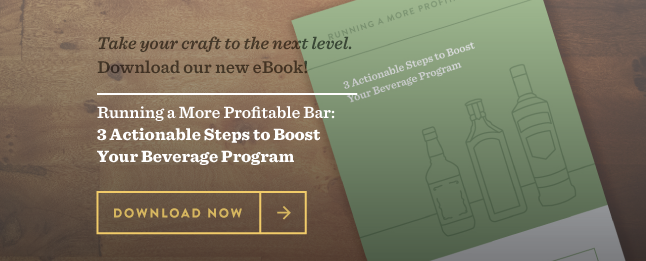
Schedule 15mins to chat with a product specialist
Start a FREE Trial Today! BevSpot offers full product education and account setup for all customers! No card Information needed!
Working In Boston Tech: BevSpot
What’s it like to work at BevSpot in terms of your culture?
Working at BevSpot means combining two incredibly important and fun aspects of our culture: technology and the hospitality industry. Our day-to-day office environment is very reflective of those two elements in that we’re a fast-paced technology company with world-class engineering and development talent, but we’re also very focused on being familiar with the restaurant, bar, and hospitality industry as a whole.
We have a bar in our office where everyone takes inventory using our product to connect with our users, and we also use the bar for tastings and other social events (including visits from Buffalo Trace and Wachusett Brewery).
We work extremely hard in a fun and exciting environment, so people don’t tend to rush out of here at 5 p.m. on a Friday. Instead, they want to crack open a nice beer (usually from Trillium, down the street), and hang out for a bit. You may even see a few people jammin out with a couple guitars and drum boxes at 2 a.m…
How to Become a Certified Beer Geek
If you work in the beverage industry, chances are, you’ve heard of a Sommelier.
A Sommelier isn’t just a wine-lover, but a certified wine expert; not just a waiter giving casual suggestions, but rather someone who has undergone special training to become highly knowledgeable in all aspects of wine service. A Sommelier’s responsibilities include developing wine lists, training restaurant staff, and working with the culinary team to pair wines that complement food ideas.
The first Sommelier examination was held in the UK in 1969. Thirty-eight years later, the first Cicerone Certification exam was held.
What’s a Cicerone?
A Cicerone is to beer what a Sommelier is to wine.
About twenty or thirty years ago, beer was much simpler. Although a Sommelier’s primary expertise was wine, he or she was also expected to understand a good amount about beer. However, beer has come a long way since then. Many experts believe that today’s beer is just as complex and diverse as wine. Now, in order to be considered a true beer expert, you must earn a Cicerone certification.
The word “cicerone” (sis-uh-rohn) means “a guide who explains the history and chief features of a place to sightseers.”
Ray Daniels, an experienced home brewer, author, and event and festival organizer, started the Cicerone Certification Program in 2007.
Currently 48,866 Americans have some type of Cicerone certification.
The program covers five areas of study:
- Keeping and serving beer
- Beer styles
- Beer flavor and evaluation
- Brewing process and ingredients
- Beer and food pairing
There are four levels of certification:
- Certified Beer Server
- Certified Cicerone
- Advanced Cicerone
- Master Cicerone
The Four Certification Levels
1. Certified Beer Server
Because it’s the first level of the Cicerone program, the Certified Beer Server certification doesn’t require any prerequisites (you don’t even have to be allowed to drink!). In order to get the certification, you have to pay $69 and take an online exam. The format is 60 multiple choice questions. In order to pass, you must get a 75% or above.
To prepare for the exam, you can read the syllabus, click through the free study links page, or purchase additional study materials.
Certified Beer Servers should have competent knowledge of:
- beer storage and service issues
- beer styles and culture
- beer tasting and flavors
- brewing process and ingredients
Currently, there are 46,887 Certified Beer Servers in the US.
2. Certified Cicerone
To qualify for this certification, you must be a Certified Beer Server of legal drinking age. The exam costs $395 and includes a written section with short answers and essay questions as well as a demonstration section. In order to pass, you need to get an 80% overall and at least 70% on the tasting section. Certification exams are held throughout the US and sometimes in Canada. You can check the schedule here.
To prepare for this exam, you can look over the syllabus and a number of study resources recommended by cicerone.org. It’s also recommended that you participate in brewing a batch of beer (homebrew or professional) and practice tasting for off-flavors.
Certified Cicerones should have detailed knowledge of:
- retail beer storage and service issues
- modern beers and styles with some familiarity of beer history and historical styles
- flawed beers, including appropriate and inappropriate flavors in modern beer styles
- beer ingredients
- the brewing process and its common variations
- beer pairing principles and the ability to recommend reasonable beer pairings for common foods
There are currently 1,867 Certified Cicerones in the US.
3. Advanced Cicerone
The third level of beer certification requires the two previous levels of certification and the participant must be of legal drinking age. The day-long exam costs $595 and is composed of multiple written, oral, and tasting components. The written section of the exam consists of multiple choice, fill-in-the-blank, and essay questions and there are two oral sections that include hands-on beer presentation and a taste assessment.
To pass this exam, you need to get an overall grade of 80% and at least a 75% on the tasting portion. The Advanced Cicerone certification exam is held several times a year in a number of different locations. If you’re looking to take the test, the dates and registration information are announced through an email blast so make sure the email address associated with your Cicerone profile is up-to-date.
To study for this exam, you can read over the full Advanced Cicerone guide and look over a number of other resources. The Cicerone program also recommends you travel to classic beer producing areas of Europe, brew beer alone or with others, and experience preparing and presenting beer and food pairings.
Advanced Cicerones are expected to have expert knowledge of:
- all issues related to brewing beer and beer service
- in-depth theoretical and hands-on knowledge of draft systems of all types
- comprehensive and in-depth beer style knowledge
- a specific list of off flavors
The Cicerone.org Certification Directory currenlty does not provide a list for Advanced Cicierones.
4. Master Cicerone
The fourth and final certification is Master Cicerone. To take this exam, you must have passed the Advanced Cicerone exam (starting in 2018) and you must be of legal drinking age. The two-day exam costs $895 and includes multiple written, oral, and tasting components. The written section is made up of essay questions, the oral exam is conducted by industry experts and includes hands-on presentations of knowledge and the taste-test requires recognition of a range of off-flavors, a blind assessment of beer styles, and an analysis of blind sampling. To pass, you must get an overall grade of 85%. The Master Cicerone exam is held twice a year in Chicago. The dates and information are communicated via email if you have an account on cicerone.org.
To prepare for this exam, cicerone.org recommends reading these resources. However, they also generally expect that you’ve spent years studying and tasting beer, you’ve traveled to classic beer producing areas, you’ve had hands-on experience with beer service and food pairing, and you’ve brewed beer alone or with partners.
Master Cicerones have:
- encyclopedic knowledge of beer
- a highly refined tasting ability
- in-depth familiarity with brewing and ingredients
- in-depth theoretical and hands-on knowledge of draft systems
- mastery of beer styles
- off-flavor recognition
Currently, there are only 8 Master Cicerones in the US.
Because I haven’t taken a Cicerone exam myself, I was curious what the process was like. After reading his article, “The Road to Becoming a Beer Sommelier,” I reached out to Certified Cicerone, Sean Cooke from St. Paul MN, to see what his experience was like and where his certification had taken him.
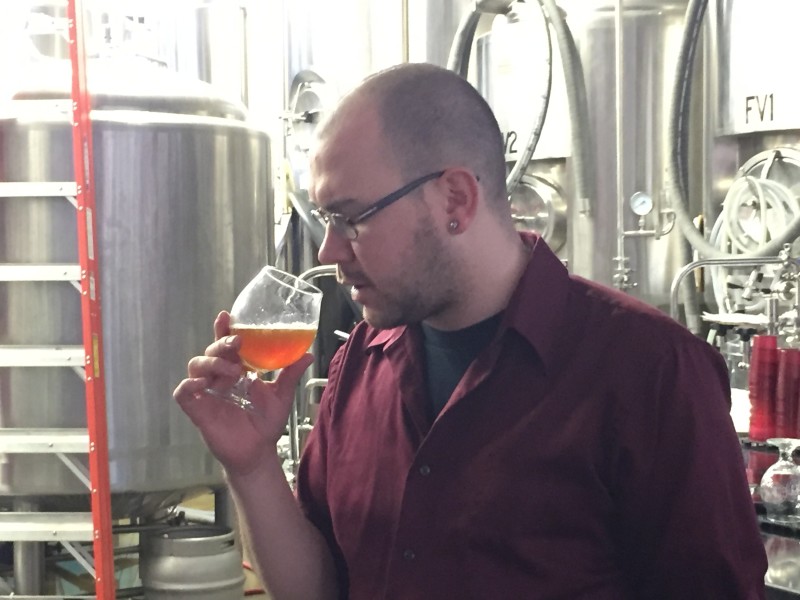
What made you want to take the Cicerone exam?
“I opened my own bar in 2012 and wanted to build a craft beer program. Originally, I didn’t know a whole lot about beer but I wanted to build a nice balanced tap list with something for everyone. There were a number of new breweries that were popping up that quickly became staples on my tap list. I became known for having cool local beers and we quickly became a craft beer bar. I then had lots of customers coming in and talking about beers with me. They would mention a style that I didn’t know and I would go home and research it. Pretty soon, I became known as a beer expert.”
“I owe a lot to my brewing partner, Gill, also. He was the one in charge of the taps at another bar in the same neighborhood. We would visit each other’s bar 2 to 3 times a month and compare our theories on making a balanced tap list. He mentioned he was a homebrewer and we began brewing beer together.”
“It was then that I began studying for the Cicerone exam.”
What was the most difficult part of preparing for the exam?
“The Cicerone exam was one of the hardest things I had ever done. It’s long, it’s intimidating, and I had to travel to Chicago because of timing to take it. I spent a lot of late nights reading articles, reading books, and watching videos on beer styles, beer history, and the brewing process. One of the hardest things was not knowing where I stood. I knew I was a beer expert, but I had no point of reference. I basically spent a year studying casually for it and then 3 months studying intensely.”
“I think the hardest part is having to drink beer when you don’t want to, or to drink a particular style of beer when you’re not in the mood after a long day of work. A lot of people joke about how hard it must be for me to ‘have to’ drink beer as part of my studying or my profession, but it’s mentally and physically draining.”
How has your certification opened doors for you?
“I only got my job as a manager at the startup, Better Beer Society, because I was a Certified Cicerone®. That was the minimum qualification for my position doing the education pieces. I work with 5 other Certified Cicerones® in my company and there are 3 of us looking to move on to the Advanced Cicerone® level and one who has his sights set on Master Cicerone®.
“Better Beer Society is an education-based beer business that is seeking to build a more educated industry from all angles. We have four major parts of the company:”
- Certification – We do consulting, training, and certification for bars and restaurants to help them build a better beer program and to show consumers that they are taking all the necessary steps to serve beer in the way that it was meant to be served.
- Draft Line Cleaning – We have a rapidly-growing line cleaning team that is setting a new standard for cleaning and extra services like draft balances, repairs, and installs
- Brand Advocates – We have a team of 25 people that does samplings at retail stores, corporate and private events. They are all Certified Beer Servers through the Cicerone Certification Program to ensure that they are the best in the field and will not give out misinformation
- Better Beer Society University – These are our public education classes. They’re lots of fun and we have collected a really great following of craft beer people looking to know more about what they are drinking
“I’ve gained a huge amount of credibility and respect in this industry. I’ve been contacted by a number of people after reading my article that wanted to do training. A few months after I became certified, a friend of mine, who owns a local brewery called me to ask if I would do quality control for their beers. I go in once a week and get paid to drink their beer and discuss the flavors to make sure they are consistent batch-to-batch. I really appreciate their dedication to quality and am happy to be a part of that process.”
“I’m also the taproom manager at Lake Monster Brewing in St. Paul, MN. We just opened the taproom in December. The company and the brewer are amazing. I’m in charge of staff training so that we have educated bartenders that can answer any of the questions the general population may have. I also work with the brewer tasting the beers and discussing the direction of the tap list. We have nothing but outstanding beers, which is the only reason I would work there.”
“Lastly, the certification gives me something concrete to tell people and let them know my knowledge and experience level. I’ve heard people say that they go to breweries all the time or talk about how many beers they have rated on those beer social media apps on their phone as if that’s some sort of credential. I have something concrete, vetted by the Cicerone Certification Program.”
Would you encourage others to take the exam? If so, why?
“I would definitely encourage others to go through the Cicerone Program. It is one of the few ways to actually have a benchmark for expertise. I am constantly surprised at the level of misinformation that’s being spread throughout the market. There are far too many self-proclaimed beer experts out there. This program is a way to back it up.”
As you can see, if you’re looking to further your career in the beer industry, a Cicerone certification can be extremely beneficial. Consumers are constantly asking for recommendations and guidance. If the Cicerone certification interests you, be sure to check out their website for next steps.
Glossary of Beverage Management Terms [Cheat Sheet]
It’s not an easy thing, to run a bar.
Bar management takes a serious skill set: hospitality expertise, product knowledge, people management, marketing efforts, organization… This life is one of long nights and never-ending numbers, and at 3 a.m. there’s nothing more tiring than getting technical.
We’ve been there, which is why we’ve created a glossary of terms for bar managers, with the aim of making your job easier.
Here, you’ll find the ultimate bar management index, with definitions of the most common bar industry terms and examples of their practical application.
Save it to your desktop, pin it up in your storeroom, share it with your team.
Learn it inside out, and prepare to find beverage management a little bit easier.
Batched Product
This refers to the combination of several ingredients or products to make a large quantity drink, or “batch”. Here’s an example: infusing spirits, such as spicy tequila (several bottles of tequila with jalapenos), or preparing a large batch of sangria. These can be difficult to keep track of in inventory.
Breakage Fee
This refers to the act of “breaking up” a case. It’s cheaper to buy an entire case of liquor because distributors don’t need to break the case apart and deal with selling the bottles individually. However, top-end products, such as Johnnie Walker Blue, are almost always broken up because it’s too expensive for retailers to buy the entire case. Often, distributors charge a breakage fee.
Call Products
A bartender will defer to the “well” brand liquor unless a customer specifies which brand they would like in their cocktail. This specific brand request is referred to as making a “call.”
Cash Cow
These are the products that bring in the bucks. Their pour cost is low, their profit percentages are high, and they fly off the shelves every weekend. Cash cows are easy to identify with the right bar tech.
Comps v. Voids
Comps—such as free drink giveaways or buying a round for regular guests—are paid for out of the pocket of the business. Voids, on the other hand, are essentially entry errors (the items go through the computer system but are never actually made, and consequently don’t cost the business anything). For accurate tracking, it’s important to ensure these items are clearly separated in your POS system.
Control State
There are several U.S. states where wholesale and, sometimes, retail sales for off-premise consumption are controlled directly by state-run government entities. The government maintains varying levels of control—from total control of all beer, wine and spirits to just spirits—in the following 18 states: Alabama, Idaho, Iowa, Maine, Maryland, Michigan, Mississippi, Montana, New Hampshire, North Carolina, Ohio, Oregon, Pennsylvania, Utah, Vermont, Virginia, West Virginia, and Wyoming.
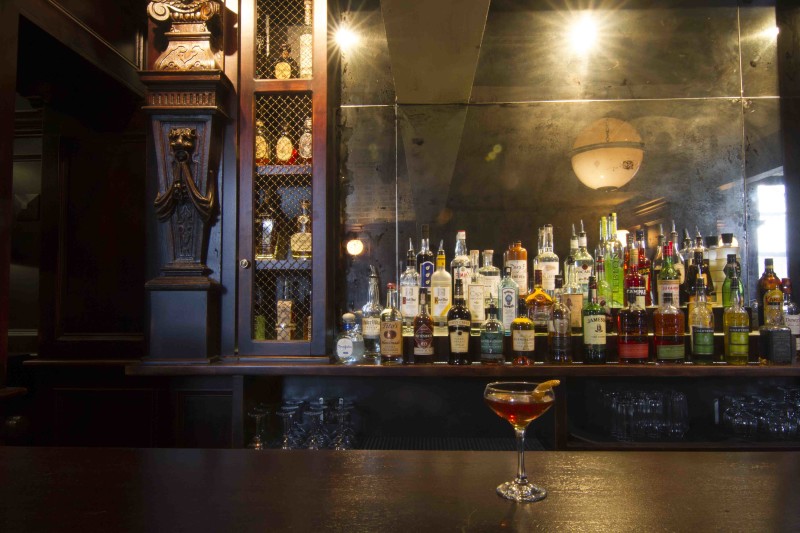
Cost Per Ounce
Cost per ounce is the formula used to price liquor. Take the total dollar amount of a product and divide it by the number of ounces in the bottle. Use this cost-per-ounce formula to price products in each group to ensure you have low, medium and high price options. Or, head to our free Drink Pricing Calculator to easily price your bar’s drinks!
Drop
The “drop” is the minimum order amount a distributor requires for any order. For example, a certain distributor may require an eight-case drop to accept your beverage order.
Lead Time
This is the total time between ordering a product, having it delivered, and it being available for use. For example, we ordered our Tito’s Vodka on Monday. It was delivered on Thursday and available for use that day. This product has a lead time of 4 days.
Loss Leader
A loss leader is a product that is sold below cost price in order to stimulate other, more profitable sales. An example would be pricing Prosecco below cost during a brunch sitting, with the aim of enticing customers to spend more on food and Bloody Marys. Loss leaders help attract attention, build a customer base, and allow you to drive up sales and prices of other products.
Download your free eBook: Guide to Bar Management
Off-Premise Retail
This refers to any retail location where beverages are sold but not available for consumption on the premises, such as liquor stores.
On-Premise Retail
This refers to any retail location where beverages are sold for consumption on premise, such as bars, clubs, tasting rooms, and restaurants.
Pars
Pars represent the minimum amount of any given product a bar would like to keep in stock at all times. By setting pars, or “stocking goals,” you can immediately know when your inventory levels for a certain item need to be reordered, and you’ll avoid sitting on too little (or too much) stock. To set a par, you need to:
- Look at your historical usage
- Calculate your average weekly usage
- Consider seasonality
- Set your target goal
See more detailed tips on how to calculate pars for your own bar.
Pour Cost
Pour costs, also referred to as your bar’s “percentages,” represent the percentage of cost that your drinks make up compared to your resulting sales. To determine your pour cost, simply divide your inventory usage by your sales. Multiply that number by 100 and throw a percent symbol at the end of it, and there’s your pour cost. Pour costs are influenced by:
- Drink costs
- Drink prices
- Product loss
Learn how to calculate pour costs for your bar.
Premium Products
“Premium” or “top shelf” liquor brands are the high quality bottles of liquor. Some establishments serve premium brands as their well brands—sometimes referred to as the “premium well”—in order to project a more high-class image.
Reorder Quantity
This is the amount of an item that needs to be restocked in order to bring the item’s sitting inventory level to its par level.
Shrinkage
Shrinkage is another term for product variance, or lost product. This is calculated as the difference in product between the amount sold and the inventory used. There are multiple causes for shrinkage, such as over-pouring, staff giveaways, and even theft. The industry average shrinkage rates are 20%. Here’s how to reduce shrinkage.
Sitting Inventory
Sitting inventory is how much product you have physically sitting on the shelf waiting to be sold. It represents sitting dollars, and too much of any product can have a negative effect on your bar for many reasons. When ordering inventory, always consider how it affects the amount of sitting product because it represents money, risk and time. See more info on sitting inventory.
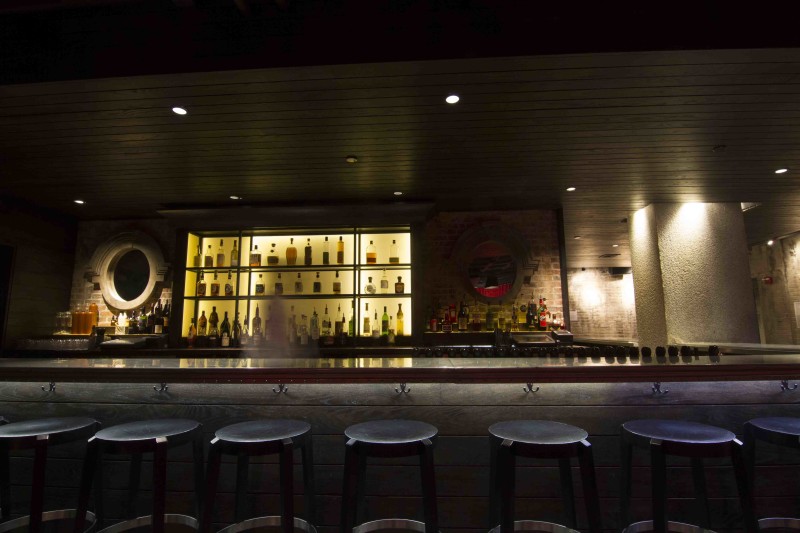
The Three-Tier System
This refers to the three-tier alcohol distribution system put in place after the end of prohibition. The pyramid generally starts with the “suppliers” or “producers” of the alcohol, which is then moved by the “distributors” or “wholesalers” down to the “retailers.”
Usage
- Inventory Usage – Inventory usage calculations indicate to a manager exactly how much of each product has been used over a defined period of time. This calculation is crucial for efficient inventory management. To understand your inventory usage, take your starting inventory, add the inventory you received during that time period, and subtract your ending inventory. See more info on how to calculate your inventory usage.
- Product Usage – You can now take this data and sort and analyze it by specific product types. Calculate usage for all of your spirits, and compare the total usage for each product type to see exactly how much vodka, whiskey, rum, and other spirits you’re selling in any given period of time (weekly, monthly or otherwise).
- Relative Usage – Now that you know how much of each type of product you’re selling, divide these usage numbers by the total usage for your bar. This will give you the percentages of product you should consider allocating to each specific product type. Apply this same process to all your product types to see how much of each spirit type you should be stocking. Determining relative usage is crucial to develop a solid product portfolio.
Weeks of Inventory
This is a term for how many weeks worth of product you have sitting on the shelf, or rather, how many weeks worth of sales your sitting inventory represents. This can be calculated by taking the amount of your sitting inventory and dividing it by your average weekly usage.
Well Products
Well products are generally less expensive liquors that are used when a customer doesn’t specify their preference. Products normally used as “wells”—vodka, gin, tequila, rum, whiskey, bourbon—cost the least and are poured the most.
Variance
Product variance, otherwise known as “loss” or “shrinkage”, is one of the biggest detractors from a bar’s profitability. It represents the difference between the amount of product sold over a given period of time, and the amount of product used over that same period. Variance can be calculated as the cost of the product sold divided by its usage. In an ideal world, these numbers would line up perfectly, but, as we know, that isn’t the case in the industry. Find out how to calculate variance for your bar.
But you know what?
Even with this guide and its simple explanations, the painstaking tasks still remain. You still have to calculate your inventory, analyze pour costs, call all your reps, and finish complicated and time-consuming profitability calculations.
That’s why we’re here. We provide software that can do it all for you. Schedule a quick demo with one of our product specialists, and see how BevSpot can make beverage management easier.
Or, for more help managing your bar, check out our easy-to-use resources and bar management tips.
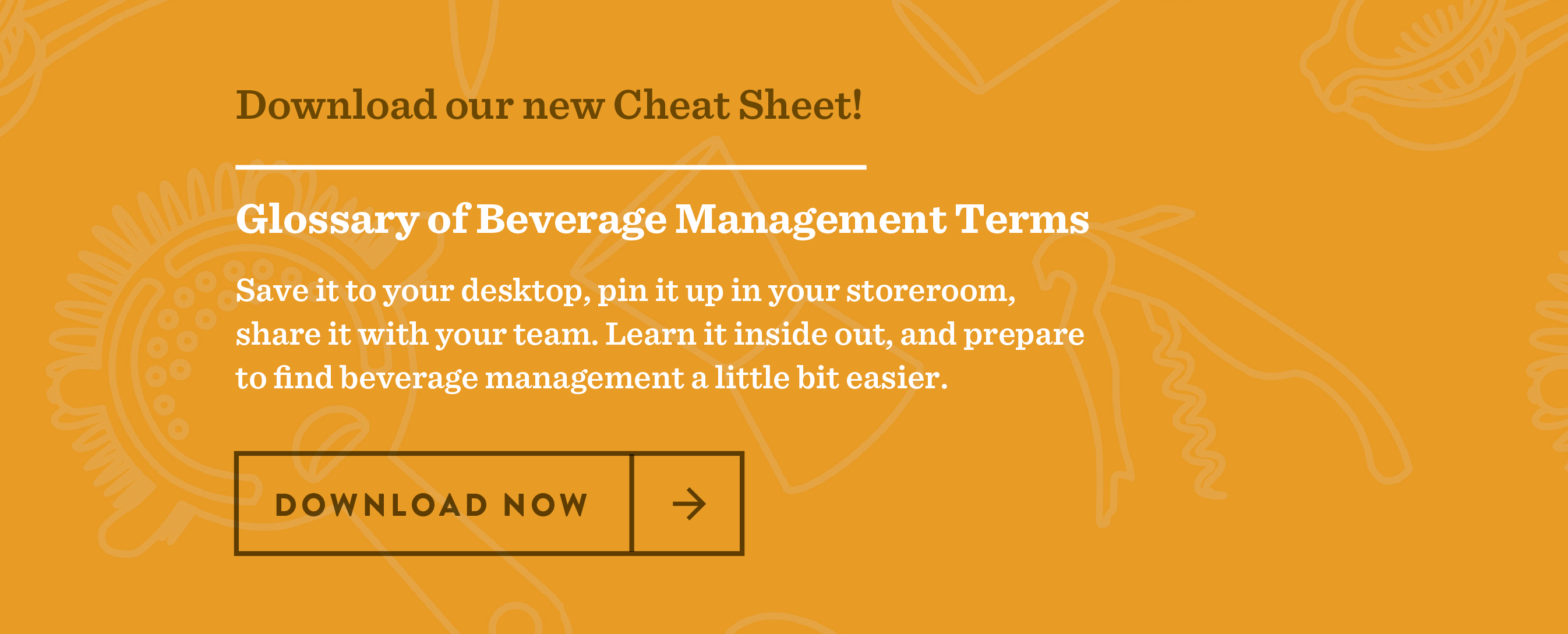
Interview: BevSpot Platform Aims To Be One-Stop-Shop for On-Premise Retailers
The alcohol industry is quickly digitizing. New programs and platforms help bars and restaurants more efficiently do business. This includes BevSpot, a Boston-based tech company that streamlines bar management processes.
Using the BevSpot platform on a phone, computer or tablet, customers can input inventory, place orders across distributors and import sales data for analysis.
We recently spoke with Rory Crawford, co-founder and CEO of BevSpot, about the product:
CH: How did BevSpot come about?
RC: Six months before attending Harvard Business School, I had started an online wine sales company as a side project. After a few months working on that project I realized two things: 1) There was a significant lack of software to benefit the alcohol industry, and 2) My original idea was not a good business….
12 Ways Boston Bars are Boosting Business on Winter Weeknights
It’s 8pm on a bitterly cold, dark Tuesday evening. You might expect Good Life, a nightclub and bar in the heart of downtown Boston, to be a bit quiet, but surprisingly, it’s lively with sound.
Because now, the usual Tuesday evening scene at Good Life looks like a group of friends sitting in the corner drinking beer and playing cards, some college kids munching on nachos and playing Mario Kart, and a bunch of coworkers dressed in suits playing Jenga at the bar.
By switching it up and making Tuesday night Game Night, Good Life entices people to visit on a night they normally wouldn’t think to go out. It might be frigid out there, but Bostonians are down to play some board games, socialize, and sip some cocktails.
Game Night is just one example of the many creative tactics Boston bar managers are using to bring in business during typically slower winter weeknights. Looking to bring more buzz to your frosty midweek? Check out these 12 bar specials:
Food and Drink Specials:
1. Pancakes for Dinner
What better way to lure Bostonians away from their Netflix binge than breakfast for dinner? Every Monday from 5:30-10:30pm this winter season, Five Horses Tavern in the South End is offering Not Yo Mama’s Pancakes. Just like the name suggests, these things are the real deal. For $12, Chef Erica Keefe whips up a batch of pancakes with a choice of three different batters and toppings such as blueberries, bourbon apple, or Froot Loops. Customers can choose to pair their yummy pancakes with a hot cocktail like a house-made maple butter and Vermont’s Dunc’s Maple Rum or a Spiked Hot Chocolate.
2. Mangia Monday
Even more expensive restaurants are dropping their prices. Every Monday this winter at Papa Razzi, all entrees are only $15.99. Patrons can also add an appetizer, pizza, antipasto, or salad for only $7.99, and a glass of house red or white wine for only $5.99. (Keep in mind, a purchase of an entree is required in order to get the special app and wine pricing).
3. Taco Tuesday
Need to bring more buzz to your Tuesday night crowd? Although it’s a bit more common than breakfast for dinner, Taco Tuesday is a classic favorite. Boston Mexican spots like Zuma Tex Mex Grill offer $1 beef and chicken tacos in hopes of drawing in more customers (who will also likely buy a specialty margarita).
Even if your menu isn’t Mexican themed, don’t fret, Taco Tuesday can still heat up your Tuesday evenings! Although they don’t usually offer Mexican style dishes, traditional American bar, Tremont 647, and seafood restaurant, Barracuda Tavern switch it up to offer $2 tacos and promote a list of Mexican-style drinks on Tuesdays. You can also grab three tacos for $6 if you sit at The Met Back Bay bar.
And just because it has a nice ring to it, tacos are not limited to Tuesdays. Lolita Cocina & Tequila Bar has Mexican Mondays where they offer all you can eat tacos for $9 after 5pm with a drink purchase.
4. Burgers on a Budget
Got a dollar? You have enough for a meal at McGreevy’s! On Tuesdays from 4-11pm, this popular spot lures in Bostonians with the promise of $1 cheeseburgers (extra toppings cost extra). The Lansdowne Pub also offers discounted burgers for $5 on Wednesdays from 4-7pm and Bar Louie offers a $5 burger with tots on Tuesday from 5pm til close. Although these bars aren’t bringing in a large profit from their burgers, the weeknight discount brings in more customers who will likely spend money on drinks and more food.
5. Cheap Wings
Get people off the couch with a wings special! Boston’s Penguin Pizza offers 25 cent wings on Mondays after 5pm and at Red Hat, Monday’s wings are only 10 cents! What’s even better than 10 cents? Flann O’Brien’s offers free chicken wings after 9pm on Mondays with the purchase of any beverage.
Wing nights are a celebrated evening for Bostonians. If you’re looking for more weeknight business, consider giving this idea a test-run.
6. Wine Night
Warm up your customers with an awesome wine special! Every Monday night, Lincoln Tavern offers wine bottles at an incredible discount. Think $50 bottles for only $25, as an example. The wine special list usually includes around 6 different bottles choices with a mix of reds and whites so all type of wine lovers can get their fix.
7. Alcohol Tastings
Bring in business during the week by inviting vendors in to sample their product during slower hours. Reach out to companies like Downeast Cider by contacting their event managers or sales reps. Once you agree on a date, print out some flyers or write it on your sandwich board and website to let people know a tasting will be taking place.
Providing free samples and hosting some lively event staff will definitely get people pumped to come in on a cold winter night. It will also help you build relationships with new vendors.
Entertainment:
8. Karaoke
Winter weather tends to keep people cooped up. Inspire them to put down some drinks and belt it out with a good group of friends by hosting a Karaoke Night! Here in Boston, the Bell in Hand Tavern hosts karaoke starting at 9:30pm on Tuesdays. They also use this time to push comfort food specials including Buffalo chicken nachos, chowder, and burgers. Kinsale, an Irish pub in Government Center, also hosts karaoke every Thursday, offering their own comfort food items like Reuben egg rolls and truffle tots.
9. Trivia Night
We realize that nowadays you can answer almost any question by typing it into Google, but where’s the fun in that? Trivia night is perfect for people looking to test/prove their knowledge of random facts or those who are simply looking for an excuse to come up with a hilarious team name and drink some beer on a Wednesday.
Stump Trivia, a popular trivia company founded just outside of Boston in 1999, hosts about 400 events a week. According to their website, by adding trivia night to your arsenal, you can turn one of your slowest nights into one of your busiest nights.
Even if Bostonians have to trudge through the snow, they pack Clery’s trivia night every Wednesday and Coogan’s trivia every Thursday. Other bars around Boston experience similar results Sunday-Thursday throughout the week.
10. Paint Nite
Looking to fill some seats on a slower night? Partner with Paint Nite to bring in customers during the winter. According to Paint Nite’s website, hosting a Paint Nite party brings in added foot traffic and “89% of Paint Nite customers have never been to your bar, 78% of Paint Nite customers have never heard of your bar, and 68% of Paint Nite customers will return to your bar.”
Tons of bars around Boston are hosting Paint Nites on a weekly basis. For example, Hong Kong in Faneuil Hall is hosting a Paint Nite on Tuesday February 9th and The Baseball Tavern in Fenway is hosting one on Wednesday February 10th.
11. Live Music
Live music is a great way to attract more people to your bar midweek. The Junction in South Boston hosts live music most weeknights and showcases an incredible amount of local talent. Mr. Dooley’s, an Irish bar, and the Green Dragon Tavern, a traditional American pub, also host a bunch of different artists to bring in more customers throughout the week.
12. Extreme Bingo
Like bingo, but much better. This updated version of bingo uses songs, videos and pictures instead of numbers. Whiskey’s on Boylston street hosts Extreme Bingo every Monday night from 8-10pm and MJ O’Connor’s hosts every Tuesday night from 8-10pm. Winners of each round win a gift card and it’s free to play!
Winter is here but that doesn’t mean your business should settle for slower weeknights. These Boston bars are stepping it up and getting creative, ensuring that their patrons have something to look forward to, besides going home and getting warm in bed.
**Did we miss your weeknight special? Comment below and we’ll be sure to share it.
Schedule 15mins to chat with a product specialist
Start a FREE Trial Today! BevSpot offers full product education and account setup for all customers! No card Information needed!
Spotlight: Behind the Bar at The Barking Crab
We know it’s the middle of winter. And, just like you, we’re counting down the days until it’s once again acceptable to frolic along the beach devouring juicy lobster meat. But how much longer must we wait for the frost to clear before enjoying fresh seafood by the harbor? The answer is this: No time at all.
In Boston’s Fort Point neighborhood lies an urban respite offering that Cape Cod summertime feeling we’re so dearly missing. It’s a well-known seafood haven among locals and even visitors. Delivering the dream of year-round summer eats, it’s The Barking Crab to the rescue.
The Barking Crab has been a Bevspot customer for a while now, so we sat down with Matt White, the General Manager, to inhale a quick lobster roll and see how his beverage management program is going.
Margarita in one hand and king crab claw in the other, here’s what he told us.
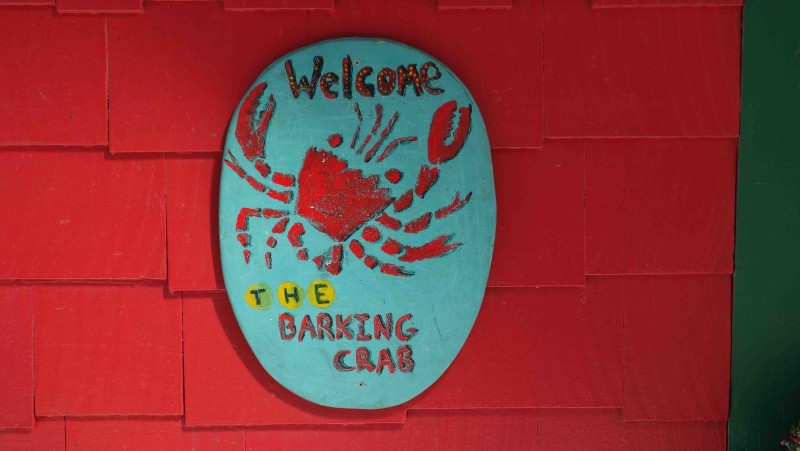
How did you get into the beverage industry?
Matt started waiting tables in New Jersey when he was 14 years old, “I worked at a family-owned Italian restaurant for three years, and then got a job at a pizzeria/sports bar that was legendary on the Jersey Shore. The owners there really took me under their wing; they made me an Assistant Manager and I was bartending full time.”
Then one day, at a party in the restaurant he was running, Matt’s uncle departed some industry wisdom: “He said to me, ‘If you’re going to stay in the restaurant business, you’re not going to make anything of yourself in Central Jersey, so why don’t you come up to Boston and open up Summer Shack with us?’”
Matt spent 12 years at Summer Shack in the role of Bartender and Bar Manager, managing the bar’s operations, inventory and ordering, and developing a cocktail program.
He then came to The Barking Crab in the summer of 2013 and never left.
Favorite cocktail to make?
“Coming from a casual seafood restaurant, a good margarita—fresh lime, any type of Hornitos, Cointreau, and a splash of Grand Marnier (with salt on the rim, of course).”
Favorite cocktail to drink?
“I’m mostly a wine drinker, but the John Daly was my summer cocktail this year—lemonade, iced tea and vodka.”
Favorite wine, then?
“California chardonnay is my favorite, but during the summer it’s rose.”
Favorite food and drink pairing?
“White wine and charcuterie.”
Top must-have bar tool?
“A hand juicer. We don’t even have Rose’s lime juice on our bar. Everything’s gotta be fresh.”
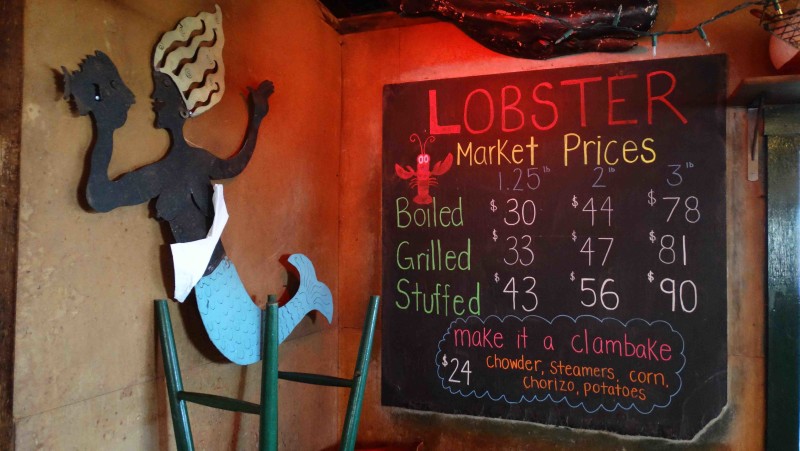
Best bartending or customer story?
When Matt was working at Summer Shack, which is right near Fenway, he had to deal with some interesting customer situations.
Summer Shack is the pre-game and after-game boozing spot, he says, so happenings like the story below weren’t uncommon.
“One day, these three older customers came in (two men and a woman). They were so drunk, annihilated. They sat down and ordered some food, and then the woman began to dry-heave. I thought to myself, “Here we go.” They grabbed their lobster bucket, put it on the ground, and pushed her head underneath the table. And they just continued to eat while this poor girl is vomiting all over the middle of the restaurant! They’re just sitting there, eating their seafood dinner, while the servers are collecting all their drinks. Come on! Be a friend and at least take her to the bathroom!”
How do you keep a fresh spin on menu items?
The Barking Crab’s menu changes seasonally. During summer, everything on their menu is fresh and locally sourced throughout New England.
“We’ve got our basic year-round items, of course, but our crab is not from New England because the only crab here is Jonah, so Snow Crab and King Crab come in year round. But we go back to basics during winter because there’s not a lot of local produce around. However, as the summer opens up, what’s available is what we sell.”
What are your top sellers?
Fresh lobster and crab, fried seafood (fish and chips are the big one), and the lobster rolls are The Barking Crab’s most popular menu items. “Our Fisherman’s Platter was actually featured on Man vs. Food six or seven years ago, which is pretty cool.”
Your best piece of advice for aspiring Bar Managers or General Managers?
Matt believes the most successful managers are those who cross-train every position in their restaurant, “This means the door guys know how to host, the hosts know how to bus, and the bartenders and servers are all cross-trained.”
Staff promotions and professional growth are also important at The Barking Crab.
“And, in all fairness,” Matt says, “The most important thing is to treat your staff like adults. I would never ask my staff members to do anything I wouldn’t do.”
“Generally, if you take care of them they’ll take care of you, which is only going to make your job easier.”
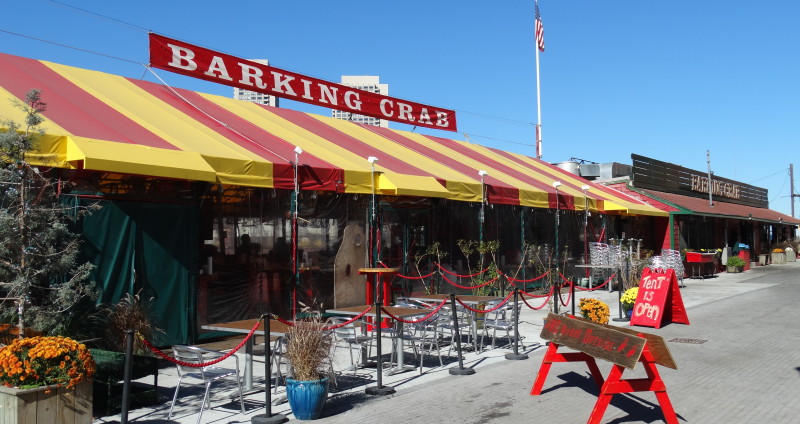
Do you read any industry blogs?
“I do bounce around on blogs. I always read Eater, Curbed (for real estate), and Bostinno.”
What does the future look like?
Matt has been in Boston for 14 years now.
“You get so invested in the restaurant scene here, and I’ve built so many connections that to start over in another city would be crazy. The General Managers all bounce around and we all know each other…Boston is such a small city.”
He also prides himself on building strong relationships with his staff members.
“I’ve had staff follow me because they’re loyal and they’ll go with you wherever you go. And often the regulars follow, too. It’s all constantly revolving,” he says.
“Now, I just have to wait another 10 years until I’m into consulting.”
Favorite thing about BevSpot?
Matt has been taking inventories for 14 years, and, like most industry professionals, he was trained to do them in Excel.
“When I came to The Barking Crab, they were using another inventory software system, which was terrible. It was so inaccurate that we ended up making manual adjustments all the time, so I pulled that out and we went back to using Excel.”
He then sat down with his colleague, Josh, for a demo with BevSpot.
“Afterwards, I turned to Josh and said, ‘This is the best thing in the world.’”
We set up The Barking Crab’s account with Josh, but Matt wasn’t able to attend the onboarding session.
“I wasn’t even trained on how to use BevSpot, but you don’t need to be—it’s so user-friendly.”
At the end of the month, Matt pulls Josh’s inventory from the BevSpot system. “I go right in and export his inventory to Excel, which is amazing, and it goes straight into my month-end summary and picks up where I left off. Even POS systems don’t do that… Why can’t it all just sync in, like BevSpot does?”
It wasn’t long before they started doing all their pricing in BevSpot. Matt says the second his owner saw the sales reports and data visualizations, he was really happy. “Your developers—when they’re done perfecting the whole beverage management thing, they need to get started on the food side of this technology.”
It’s all in the works, Matt. We’re perfecting the art of bar management software first, but we’re moving incredibly fast. Industry domination is all in the plans.
Want to find out how BevSpot can revolutionize your bar? Schedule a quick demo with one of our product specialists. We’d love to tell you all about it.
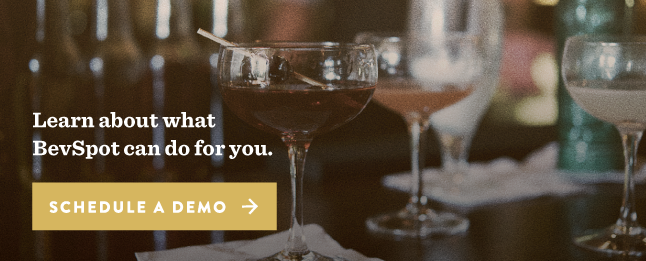
DrinkedIn: Changing the Way You Drink Alcohol
DrinkedIn started as a joke.
“We created a social drinking network for our friends, but then it just blew up.”
Haim Barad and his co-founders wanted to make something useful for the alcohol industry, a piece of technology that would change the way consumers drink and the way suppliers, distributors, and retailers sell.
Haim comes from a background in tech startups. “I like to think of us as high-tech people who love to drink, which has contributed a lot to the DrinkedIn culture.”
“We want to drag the alcohol industry kicking and screaming into the 21st Century.”
Their vision is to revolutionize the way alcohol is consumed and purchased, taking on the industry from the top down. “We found it difficult to find something new and different, to find great deals and boutique brands we wanted to purchase. And the concept of Happy Hour—and the way it’s advertised—is ancient.”
“It just seemed natural for someone to create tech to fix all that.”
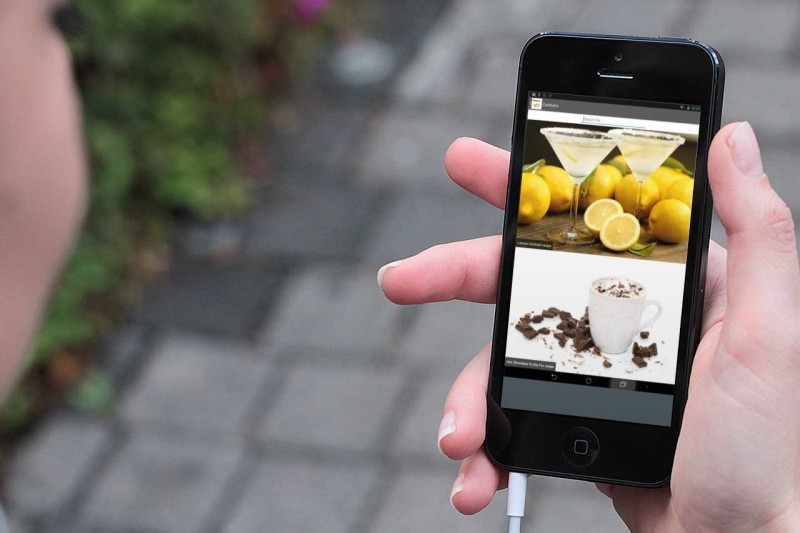
How DrinkedIn Works
DrinkedIn is comprised of both a website and an app, which are published in 27 languages and receive visits from people in over 150 countries. The app is now in its third generation and awaiting a fourth. “We’re in a launch-ready stage right now,” says Haim.
Their platform covers all three tiers of the alcohol industry, with features for the consumer, tools for the bar owner, and valuable data for suppliers and distributors.
For the thirsty consumers, DrinkedIn provides:
- A BarFinder tool, which has listings, locations, and reviews of over 200,000 bars in 30-40 countries.
- A BrandFinder tool, with retail locations of hard-to-find craft beers and liquor.
- A Cocktail Guide, with around 10,000 recipes for the at-home mixologist.
- A BarDeals feature, which lists local discounts and Happy Hour specials.
- A loyalty reward program for local bars and liquor stores.
- Coming soon: An integration with Uber and alcohol delivery companies.
All in the palm of your hand (presumably with a drink in the other).
Bar managers and owners can use DrinkedIn in several different ways. They can login and post their bar’s discounts in the BarDeals tool, offer loyalty programs to their customers, and publish and manage their listings on the BarFinder.
And for suppliers and distributors, DrinkedIn provides something a little more complex. While the website and app may be consumer-facing, Haim’s ultimate goal is to develop a model depicting the purchasing and drinking behaviors of the average alcohol consumers: “What they’re drinking, if they’re buying based on deals, what they’re searching for, where they’re located, where they shop… these types of lifestyle purchasing decisions are very valuable for suppliers and distributors.”
Haim explains how they plan to offer this type of analytical data to distributors.
“If consumers in Seattle are searching for a certain brand of whiskey, but suppliers are only distributing that whiskey in The South, the manufacturer will want to know that. The craft and boutique industries don’t have coverage and distribution everywhere, but we can show them where they need it.”
“We have many different data points that provide visibility into what consumers are doing. If we see trends that are popular, we’ll get a correlation, and then we can match these correlations with actual consumption data and offer this information to manufacturers and distributors.”
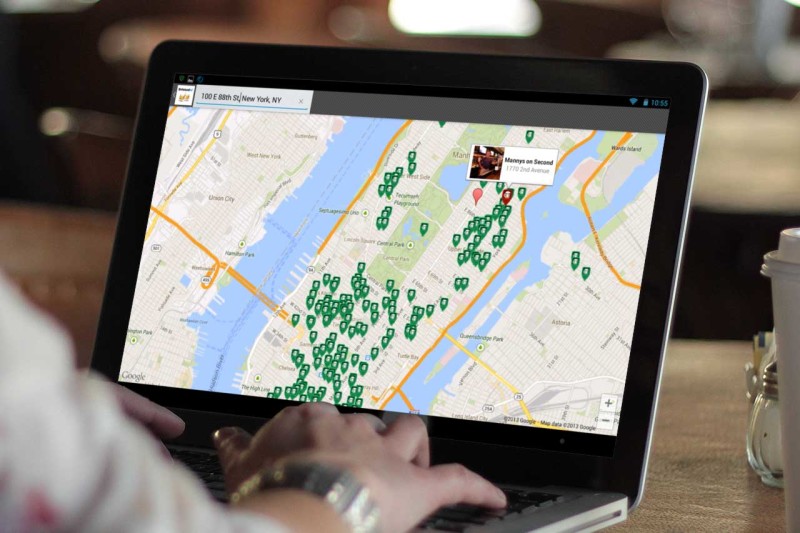
Creating Technology For the Bar Industry
We asked Haim how he feels about the way technology is disrupting the alcohol industry.
“I don’t think it’s disrupting it enough right now. It’s not a matter of the great tech that’s being offered, it’s the slow adoption rate. We’re stunned by how low-tech the alcohol industry still is, which is a great challenge. There’s no ‘Google-of-bar-tech’ out there; there’s no giant for all us little guys to compete with. But there are a lot of giant alcohol companies and even bigger chains of retailers, suppliers and distributors. We’re really just scratching the surface with the technology we can offer them.”
Here at BevSpot, we definitely share Haim’s vision. The right data and technology holds the promise of bigger savings, better management, and more time to spend on the important things.
For bar managers and owners, great technology is invaluable. And for industry tech companies, it’s really just the beginning.
Want to see what we’ve got? Schedule a quick chat with one of our product specialists. We’d love to hear from you!

Gluten Free Bar Drinks
A girl walks into a bar… and she wants a gluten free alcoholic drink.
According to a survey from The NPD Group, 30% of Americans are interested in cutting back or avoiding gluten in their diets. Reasons range from celiac disease and wheat allergies to gluten sensitivity and personal preference.
No matter the reason, it seems that gluten-free is here to stay. As a result, bars and restaurants are working hard to increase their gluten-free menu options. In order to increase customer satisfaction and avoid missing out on a huge share of your customer base, offering gluten free alcohol options can really open up the doors for your patrons.
If you’re unsure of what drinks are gluten-free, the idea of stocking your bar inventory with gluten-free options might seem a bit intimidating. The good news is, adding a few drinks to your arsenal shouldn’t put you back by much, and you probably have some gluten-free options already stocked.
To start those gears in motion, we’ve created a list of gluten free alcoholic drinks.
Gluten-Free Beer
When you think of gluten-free alcohol, your mind might jump to the new gluten-free beer trend. In order to accommodate the ⅓ of Americans trying to shun gluten, beer companies have rushed to create different styles of gluten-free beers. As a result, there are hundreds of these beers to choose from.
When you make the move to stock your bar with some gluten-free beers, you should consider taste, cost, and availability.
Taste
Unfortunately, gluten-free beer often gets a bad rap. Luckily, it’s come a long way in recent years and there are a slew of taste-testers out there who can help you find the best-tasting options. You can find their reviews on resources like Beeradvocate and other gluten-free blogs.
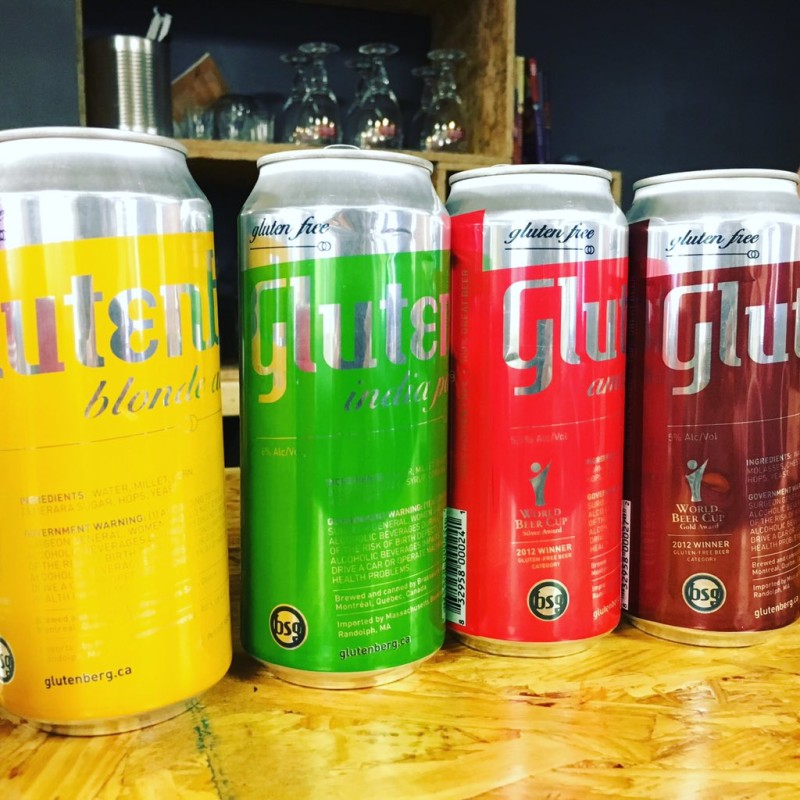
In addition to online research, you can also organize your own gluten-free beer taste test! Here at BevSpot, we decided to set up our own. Although the gluten-free beer selection near our office wasn’t the best, we were able to find Glutenberg, a gluten-free beer brewed in the heart of Montreal. We purchased a 4-beer variety pack with Indian Pale Ale, Red Ale, Blonde Ale, and American Pale Ale. Here’s what we thought (in a bulleted, unfiltered format):
GF India Pale Ale (6%)
- smells tangy, citrusy (grapefruit) and vanilla-y
- tastes pretty bitter
- super hoppy
GF Red Ale (5%)
- smells a bit nutty and vanilla-y
- it’s creamy like coffee
- crazy creamy, it’s like a vanilla milkshake
- taste some brandy
- extra carbonated for a red ale
- it’s got a toastiness to it
GF Blonde Ale (4.5%)
- doesn’t smell like much, smells like a keg in college
- doesn’t really taste like anything
- maybe tastes like honey in sparking water
- has some ginger notes
- it’s smooth
- some tartness
- kind of tastes like Bud Light
GF American Pale Ale (5.5%)
- I would drink this
- it’s quite nice
- slightly hoppy
- a little bit malty
- kinda tastes like beer
- a little more tart
All in all, we felt Glutenberg was a pretty decent alternative for gluten-free drinkers. It didn’t taste too different compared to a regular beer, and we discovered that the brewery won gold, silver and bronze awards in the “Gluten-free beer category” at the 2012 World Beer Cup.
Cost
A mass-produced six-pack of gluten-free beer like Redbridge usually costs between $9 and $10. More crafty, small-batch beers like the Alchemist Celia Saison cost almost $11. You can stock your bar based on your own preference or the feedback you get from customers. Either way, when you price your drink, you should aim for a pour cost of 20%. To figure out the right pricing, test drive our drink price tool!
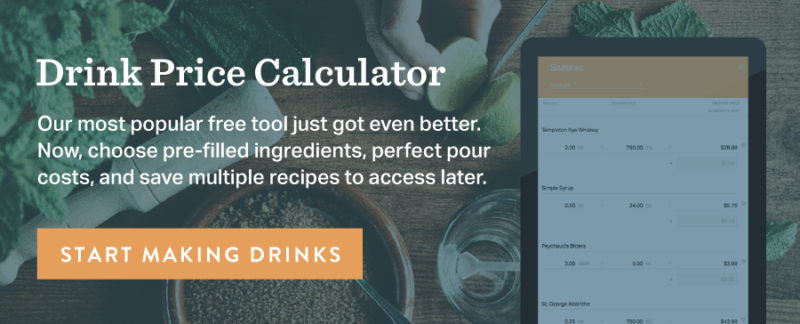
Availability
Depending on where you’re located, some gluten-free beer might be hard to get your hands on. Some of the craft beers might not be supplied to your city or state, in fact some of the highest-rated gluten-free beer is brewery-only. You also might be surprised to find that even Anheuser Bush’s Redbridge is sometimes difficult to find. Check with your suppliers to see which beers are supplied to your area!
Beer Suggestions: Stock your bar with some popular favorites like Stone Brewing Co. Delicious IPA, Omission Lager, and Harvester Fresh Hop IPA.
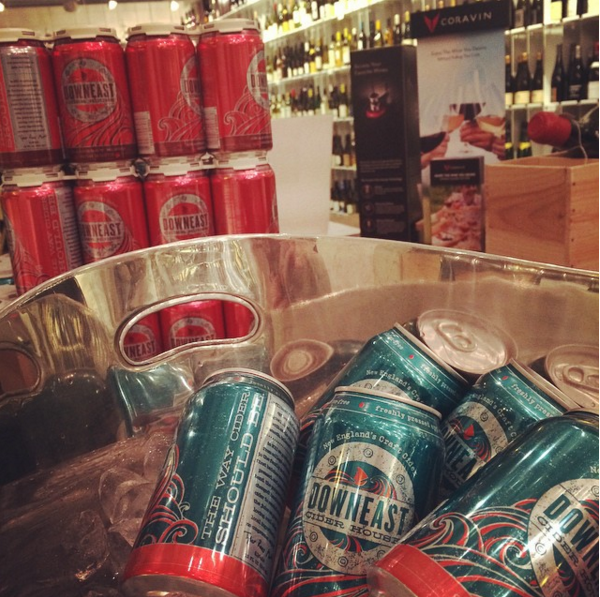
Gluten-Free Hard Cider
Luckily, most hard cider is a viable gluten-free option. Many cider houses confirm that their products are gluten-free. However, watch out for ciders like Hornsby’s and Harpoon because they contain trace amounts of gluten. You definitely don’t want to accidentally offer these as gluten-free options to your patrons.
For an added bonus, make room for a gluten-free cider or two on draught!
Cider Suggestions: To give your customers some variety, purchase filtered cider options like Woodchuck, ACE, and Angry Orchard or unfiltered cider like Downeast.
Gluten-Free Wine
Most wine is gluten-free (below the legal limit of 20 parts per million of gluten), with the exception of wine that has added flavors or coloring such as some dessert wines.
Although most gluten-free people will be able to consume any type of wine, if you want to go above and beyond, consider purchasing a wine option that’s aged in stainless steel casks and not fined with micronized wheat to avoid cross-contamination.
Wine Suggestions: Cupcake Vineyards claims to be gluten-free because they avoid using wheat, barley or rye during production, and Frey Vineyards is completely gluten-free because they use stainless steel casks and only use bentonite clay as a fining agent.
Gluten-Free Liquor
The National Institute of Health advises that distilled alcohol is gluten-free, regardless of its original source. In this case, any unflavored vodka, gin, rum, and whiskey should be a safe gluten-free option. However, experts still disagree whether celiacs and the gluten-sensitive can consume distilled alcohol originally derived from gluten grains. To play it safe, some gluten-free customers might ask for liquor made with potatoes or grapes, or tequila that is 100% agave.
Liquor Suggestions:
Vodka: Consider stocking your bar with Tito’s, a popular potato-derived, gluten-free favorite, or with some of these other gluten-free vodka options.
Gin: If customers are looking for a gluten-free gin option, stock your bar with gin made from potatoes such as Maine Distilleries’ Cold River Gin or Monopolowa Dry Gin.
Rum: When it comes to rum, most are gluten-free. However, Bacardi Superior has confirmed all of their products are gluten-free with the exception of Bacardi Silver. If customers are looking for dark rum, you can offer them Captain Morgan.
Whiskey: Queen Jennie Whiskey, crafted by the Old Sugar Distillery, is a gluten-free Whiskey option.
Tequila: Offer quality 100% agave tequila like Espolón Reposado or Patron Silver to gluten-free consumers and to customers looking for quality, classically made tequilas.
The Wrap-Up
If you’re a little overwhelmed by all of these added options, fear not; you don’t necessarily need to stock gluten-free options for every single type of alcohol. After you decide which gluten-free options to include, be sure to create a separate drink menu listing the specific offerings, and advertise your gluten-free drink menu.
As you test out your gluten-free drink menu, use BevSpot to track your gluten-free beverage sales in order to continuously make informed purchase decisions. Stocking your bar with a high-demand, gluten-free variety will help you expand your customer base, meet customer demand, and set yourself apart from the competition.
Schedule 15mins to chat with a product specialist
Start a FREE Trial Today! BevSpot offers full product education and account setup for all customers! No card Information needed!
Craft Cocktail Resource Spotlight: A Bar Above
When Julia Tunstall first met her future husband, Chris, he was an experienced but frustrated bartender. From starting off at a craps table in Vegas, moving up to a fine dining behind-the-bar gig in Napa, and finally running the bar program at the acclaimed Wayfare Tavern in San Francisco, Chris had a knack for the hospitality industry. With a growing passion for craft cocktail creation, the frustration quickly creeped in when he realized how little information there was on the internet to educate aspiring mixologists like himself.
That’s when the idea for A Bar Above came into play, a domain name which, as Julia tells me, Chris registered two weeks before asking her out on their first date.
As the saying goes, behind every great man is a great woman, and so that registered domain name sat unused while Chris found and married his great woman, Julia. In 2013 after buying a house, the two decided it was time to re-hash that idea from a few years back. While Chris built a home bar in their new basement, Julia took her small business tech and marketing background and learned how to create a website.
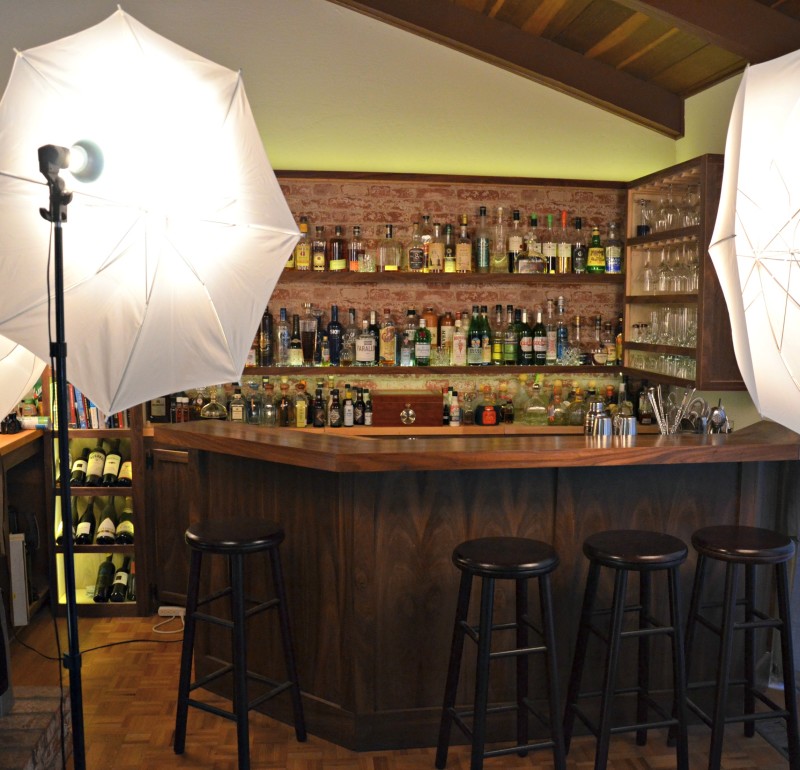
I sat down for a chat with Julia on how that website looks today, and to learn more about the very exciting online summit coming up in April:
It sounds like you’re running the show behind A Bar Above, but tell me about the influence Chris had on the project, and what it was like to start a company together.
I think we work very well together because we have very different skill sets. Chris has always been our expert on hospitality, bartending skills and mixology. Meanwhile, I’m in charge of keeping the lights on – both the technical side with the website, managing our writers, and keeping up with all of our marketing efforts as well.
We like to provide advice for people aspiring to manage a bar. Is there any advice that Chris often gives to people entering the industry?
We’ve talked about getting started in the hospitality industry a couple of times on our blog and podcast, and the key thing that Chris always emphasizes is just how small of a world hospitality is. When you start, you may not know many people – but ten years later you’ll know just about everyone! The industry really is all about the people, so take care of each other, be good to the people you work with and go the extra mile. This includes the vendors that you work with as well.
For managers specifically, Chris has talked to me about how managing a bar is a very different skill set than being a waiter or a bartender. If you are interested in becoming a bar manager, it’s important to develop your understanding of the business. You can do this through books and videos, but one of the best ways is to find a good manager and learn as much as possible from that person. There is nothing like finding a good mentor to accelerate your learning curve.
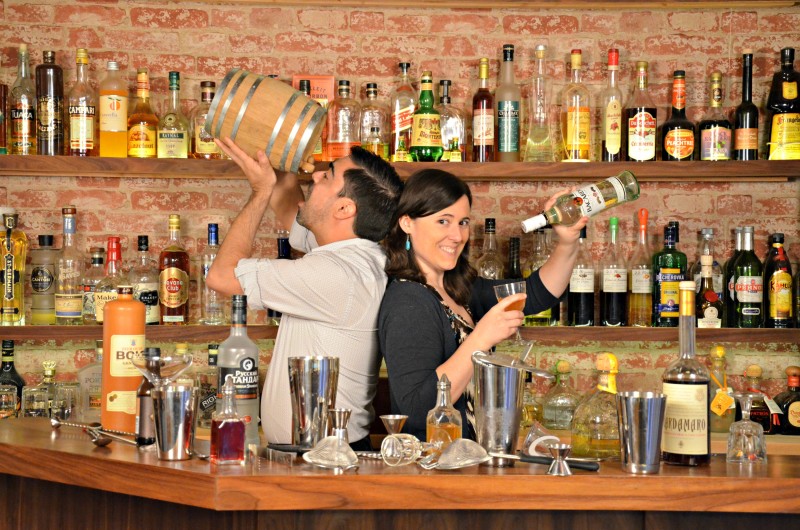
A funny or impactful story you’ve experienced since starting A Bar Above?
This is one of my favorite stories – and of course, it takes place at a bar! I was tagging along with Chris as he met with a spirits rep at a bar in San Francisco. We were all chatting and making conversation when a very tall (and very handsome) bartender leaned over, looked right at me and said, “Julia?”
If looks could kill, I don’t think that bartender would’ve survived Chris’ stare! Of course, I didn’t know the bartender at all – it turned out he recognized my voice from our podcast! He excitedly introduced himself to Chris and me and we had a good laugh. That was the first time anyone had recognized me at a bar and it was quite a surprise.
Tell us about A Bar Above’s Summit in April. What are you hoping for attendees to gain from tuning in?
The Craft Bartender Summit is an idea we’ve been kicking around for a couple of years now. It all started the first time we went to Tales of the Cocktail in 2013 and wrote about it on our blog. We received several emails and comments from frustrated bartenders who said they wished they could go to great events like Tales, but simply didn’t have the budget or time off. (And we had the same problem – Chris had to take a week of unpaid leave and it was really hard to get his manager to agree!)
The Summit is our “solution.” We’re getting six great industry experts to record seminar videos that we’ll play on the web on April 17th. The speakers will be watching too – and live in the chat box for questions as well. While we haven’t announced our Seminar topics yet, I can tell you I’m really focused on actionable, useful content.
My goal is for our attendees to take what they learn and do something differently in their very next shift – either to grow their skills, their career, or just make better cocktails.
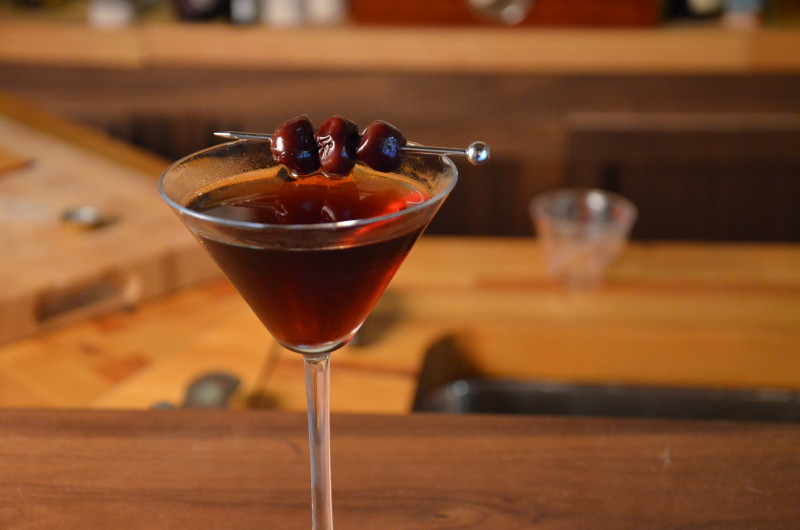
I know Chris is the mixologist in the family, but have you picked up any cocktail-making skills of your own?
I believe that a bartender’s spouse is morally obligated to learn to make their husband / wife’s favorite cocktail! (After all, you might just be the one making them a drink if they had a rough shift!) For me, that meant learning to make Chris’ absolute favorite: a Rye Manhattan. Here’s the recipe:
Recipe
Rye Manhattan
Ingredients
- 2 oz Bulleit Rye
- ¾ oz Carpano Antica Sweet Vermouth
- 2 Dashes Angostura Bitters
- Garnish with a Maraschino Cherry
And what about your favorite drink?
Tough choice! Usually I drink whatever Chris puts in front of me (and I’m very happy to do it.) I will say one of my all-time favorites is a classic Dark & Stormy. Here’s my recipe:
Recipe
Dark & Stormy
Ingredients
- 1 ½ oz Gosling’s Dark Rum
- ½ oz Lime Juice
- Fill with Ginger beer
Thanks for the great chat, Julia! We’re extremely excited to share some of our actionable tips at the upcoming Craft Bartender Summit. Sign up here to reserve your spot on April 17th, and in the meantime, study up with our newest eBook:
5 Things You Didn’t Know About… Buffalo Trace Distillery
Whiskey Distiller of the Year is no easy title to achieve, and that’s not all they’ve won.
Since 1775, the masterminds behind Buffalo Trace Distillery have created exceptional whiskey products. Their namesake Kentucky bourbon, the entire Van Winkle line, the famed Experimental and Antique collections, and the Sazerac Rye are just the beginning.
Buffalo Trace has an impressive reputation and a long line of innovative leaders. The distillery, which was built in 1857, sits on the bank of the Kentucky River, in Frankfort. Here, heavy barrels full of aging bourbon line the walls of brick warehouses. These walls are full of history, working for years as the home of some of the most desirable whiskey in the world.
We’re all dedicated whiskey supporters here, so we took a break from bar management software and sat down for a tasting with Samantha Arredondo from Buffalo Trace. While sipping on the Kentucky Straight Bourbon, both neat and in a Manhattan, this is what she told us.
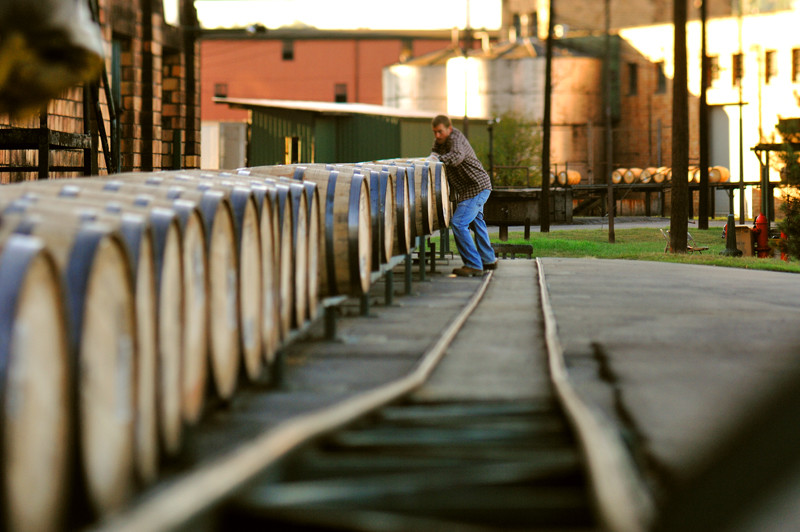
1. Buffalo Trace Distillery is the oldest, continuously running bourbon distillery in America
Buffalo Trace has a great history in the U.S. The distillery’s rich tradition dates back to the late 1700’s and has included such legends as E.H. Taylor Jr., George T. Stagg, Albert B. Blanton, and Elmer T. Lee. The distillery has never shut down, not even during prohibition.
2. Their corn is 100% non-GMO
Corn is one of the most important ingredients when making bourbon, especially when it makes up 70-80% of the product. Sourcing the best ingredients has always been a requirement at Buffalo Trace. The corn rolls in by the truckload from local farmers in Kentucky and Indiana. It’s heavily inspected; if it doesn’t meet the criteria, it is sent back to the farm. If you ever take a Hard Hat Tour at the distillery, you’ll see where the kernels make their debut and then follow them on their journey as they transform into delicious spirits.
With the distillery’s property expansion, there are now corn stalks grown on site. This corn will be used to create Buffalo Trace’s own farm-to-table “Single Estate” experience.
3. Actual buffalo roamed the lands that Buffalo Trace sits on
The buffalo that migrated on the ‘Great Buffalo Trace’ led to what is now the Kentucky River. As these buffalo headed west toward the Great Plains, they left a wide path that would be traveled by many great American explorers and pioneers, like Daniel Boone and George Rogers Clark.
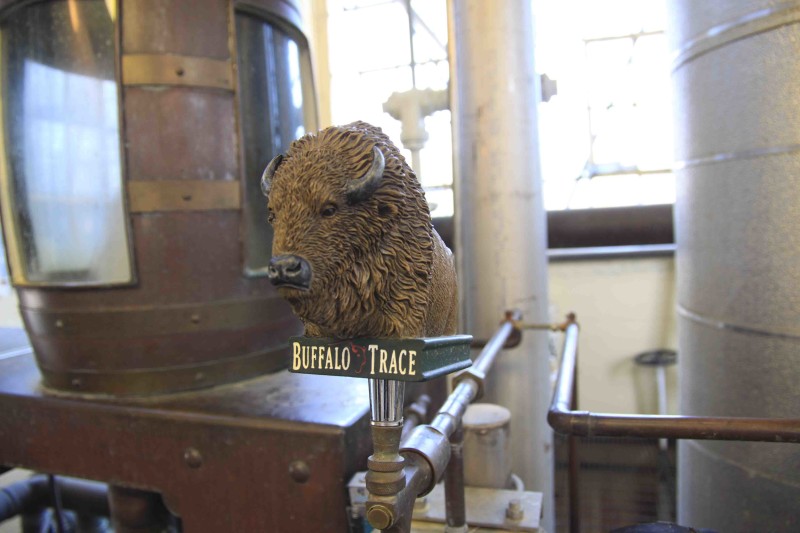
4. The distillery was open and producing whiskey during Prohibition
If you got sick during prohibition, chances are your ‘medicinal’ whiskey came from Buffalo Trace. The distillery’s existence was spared by the allowance of a permit—one of only four issued in the country—to continue distillation for medicinal purposes. In order to obtain a bottle of whiskey, you needed a prescription from your doctor to get it at your local pharmacy. Consumers received one pint every ten days.
5. The distillery is haunted
With a history dating back 200 years, it’s possible paranormal activity exists at the distillery. Although Samantha has never witnessed anything herself, she’s had the chance to hear actual accounts from the distillery’s tour guide, Freddie. They’ve apparently seen proof through pictures and heard bone-chilling stories. But don’t just take her word for it—the distillery offers ghost tours during the weekends, where you’ll hear these legendary stories and get a look into the more haunted sites on the property. Spooky.
Thanks for the chat, Samantha. Now who’s in the mood for an Old Fashioned? The Kentucky Straight Bourbon is super smooth, with sweet, vanilla flavors and fruity notes. It’s the kind of whiskey any neophyte would fall in love with, yet there are plenty of bold flavors for the connoisseur.
Need some reading material to go with that cocktail? Check out our latest free eBook: How to Run a More Profitable Bar.

